Your garden offers more than just beauty and bounty throughout the growing season. As the vibrant colors of summer begin to fade and autumn’s crisp air arrives, your plants still hold incredible value. Instead of discarding spent flowers and seed heads, you possess a fantastic opportunity to transform them into something truly special: a homemade bird feeder for your balcony or small yard. This project helps you reduce waste, nurtures local wildlife, and offers a delightful, low-maintenance way to enjoy nature’s spectacle right outside your window. Imagine the joy of watching colorful birds flock to a feeder you crafted yourself, knowing you gave your garden’s leftovers a new, purposeful life.
Attracting birds provides numerous benefits for both you and the environment. Birds offer natural pest control, eating insects that might otherwise bother your plants. Observing their habits brings a sense of peace and connection to nature, a valuable antidote to busy modern life. This guide empowers you with the knowledge and steps to create a simple, effective, and beautiful bird feeder using readily available materials from your own garden. You will learn to prepare your natural ingredients, assemble your feeder, and ensure it becomes a welcoming spot for feathered friends, even through the colder months.
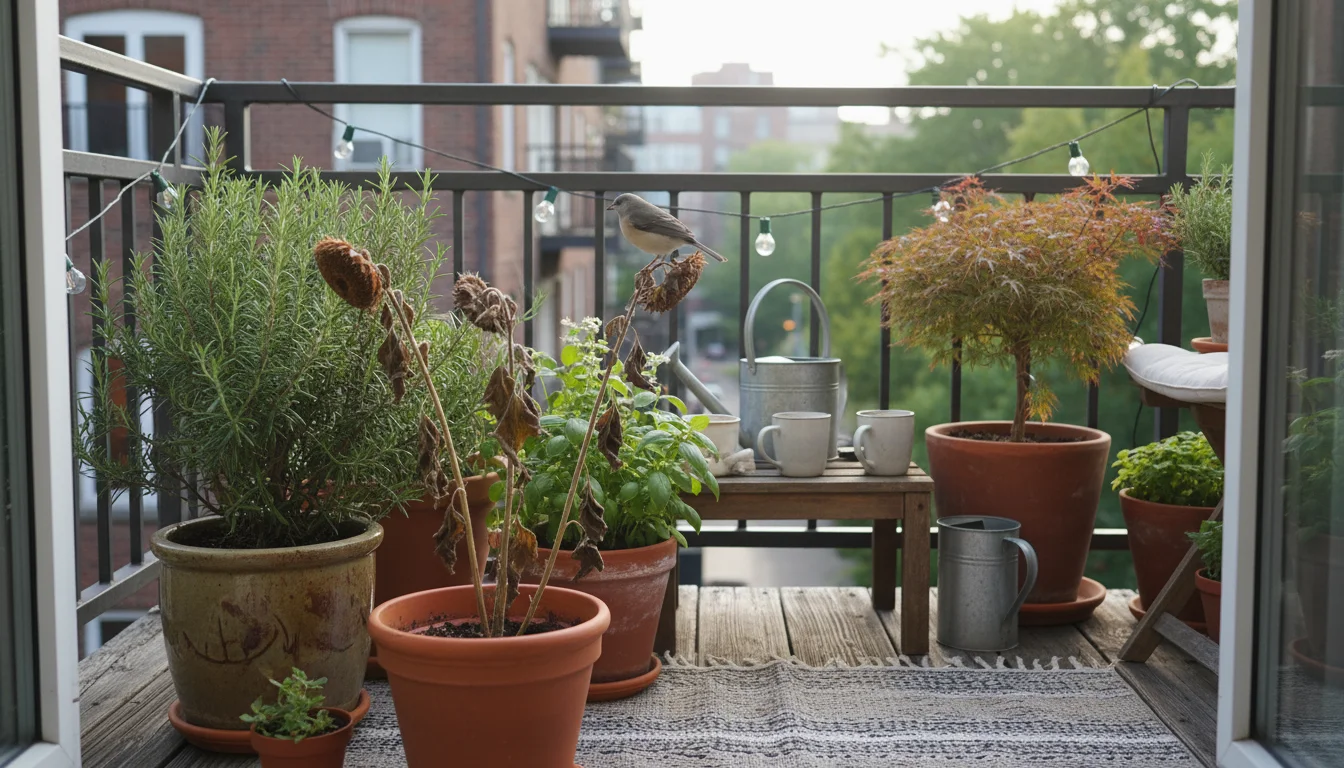
Why Attract Birds to Your Balcony? The Benefits Beyond Beauty
You might think a small balcony or patio limits your ability to contribute to local ecosystems, but that simply is not true. Every little space you dedicate to wildlife makes a difference. Attracting birds to your compact outdoor area offers a wealth of rewards, enhancing your personal well-being and supporting ecological health.

Ecological Contribution and Biodiversity
Even a single bird feeder contributes to urban biodiversity. Cities often fragment natural habitats, making it challenging for wildlife to find food and shelter. Your balcony acts as a vital stepping stone or a small oasis for birds migrating or living in urban environments. By providing food, especially during lean seasons like winter, you help birds conserve energy and improve their chances of survival. This project demonstrates a tangible way you can practice environmental stewardship, directly impacting your local ecosystem from your home.
Consider the broader impact: if every balcony or patio hosted a small wildlife-friendly feature, our urban landscapes would become significantly richer for birds and other pollinators. Your simple act amplifies this effect, creating a network of support for species facing increasing habitat loss. Research shows that even small urban green spaces, including balconies, can increase biodiversity and provide critical resources for various species. You directly participate in creating a more resilient and interconnected natural world.
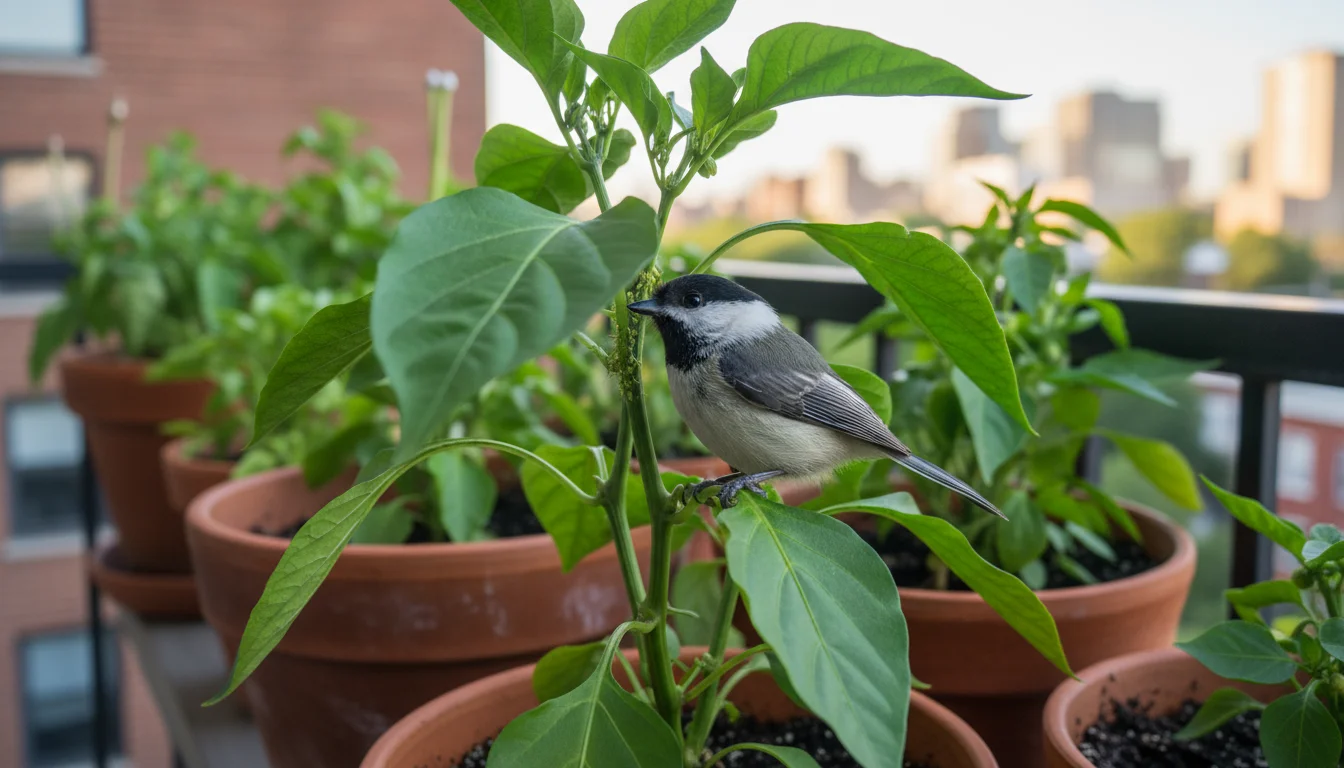
Natural Pest Control
Many common garden birds, such as chickadees, wrens, and sparrows, consume large quantities of insects. By inviting them to your balcony, you gain a natural, organic pest control squad. They actively seek out caterpillars, aphids, and other pests that might otherwise damage your container plants or small garden beds. This reduces your reliance on chemical pesticides, fostering a healthier environment for your plants, yourself, and the birds. This symbiotic relationship exemplifies how working with nature produces sustainable solutions.
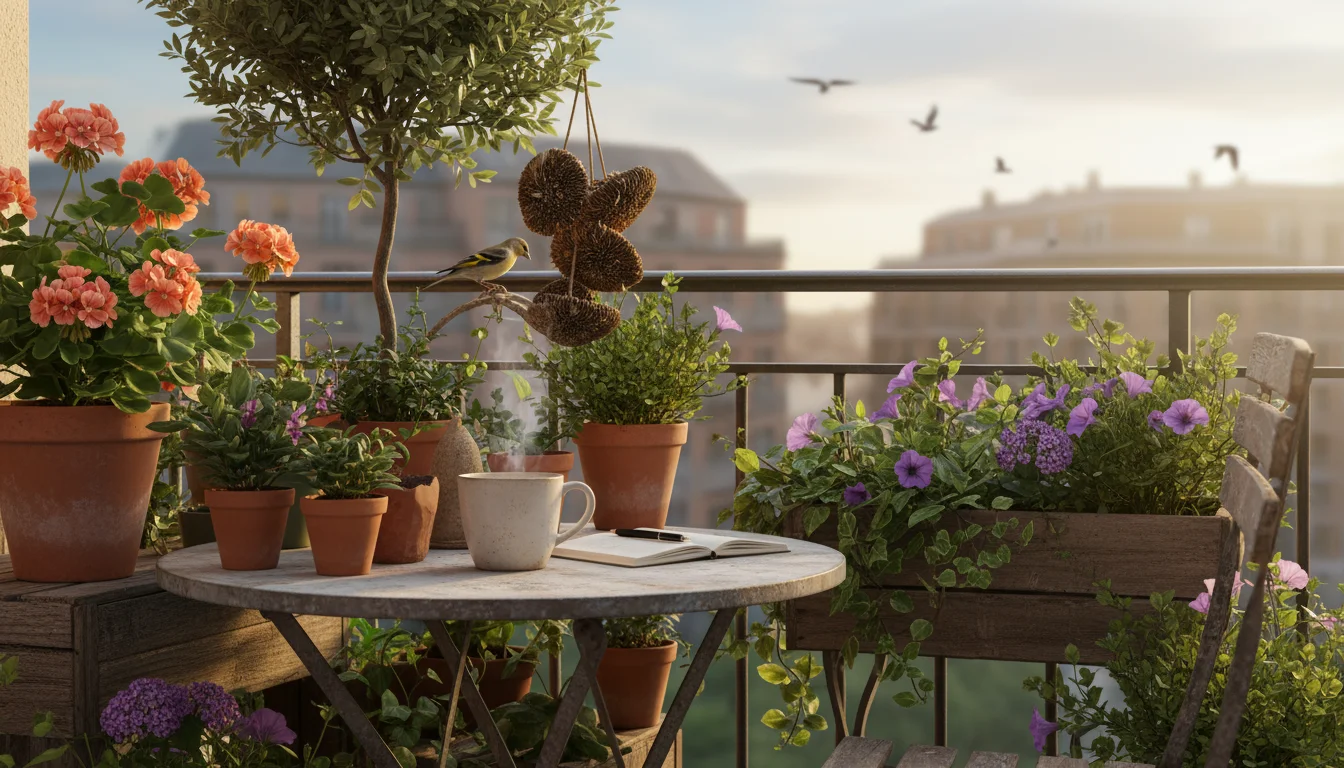
Stress Reduction and Joyful Observation
Watching birds is a proven stress reliever. The gentle sounds of their chirping and the visual delight of their movements bring a calming presence to your day. It offers a tangible connection to the natural world, fostering mindfulness and a sense of wonder. For those living in urban settings, this daily dose of nature can be incredibly restorative. Imagine sipping your morning coffee while a finch pecks at the sunflower seeds you provided. This simple pleasure transforms your outdoor space into a personal sanctuary, proving you do not need acres of land to experience the profound joy of wildlife observation.
Data from ornithological studies consistently shows that access to green spaces and wildlife observation improves mental well-being and reduces feelings of isolation. Your balcony bird feeder provides this access, directly benefiting your quality of life. It is more than just a craft project; it is an investment in your personal happiness and a commitment to nurturing nature.
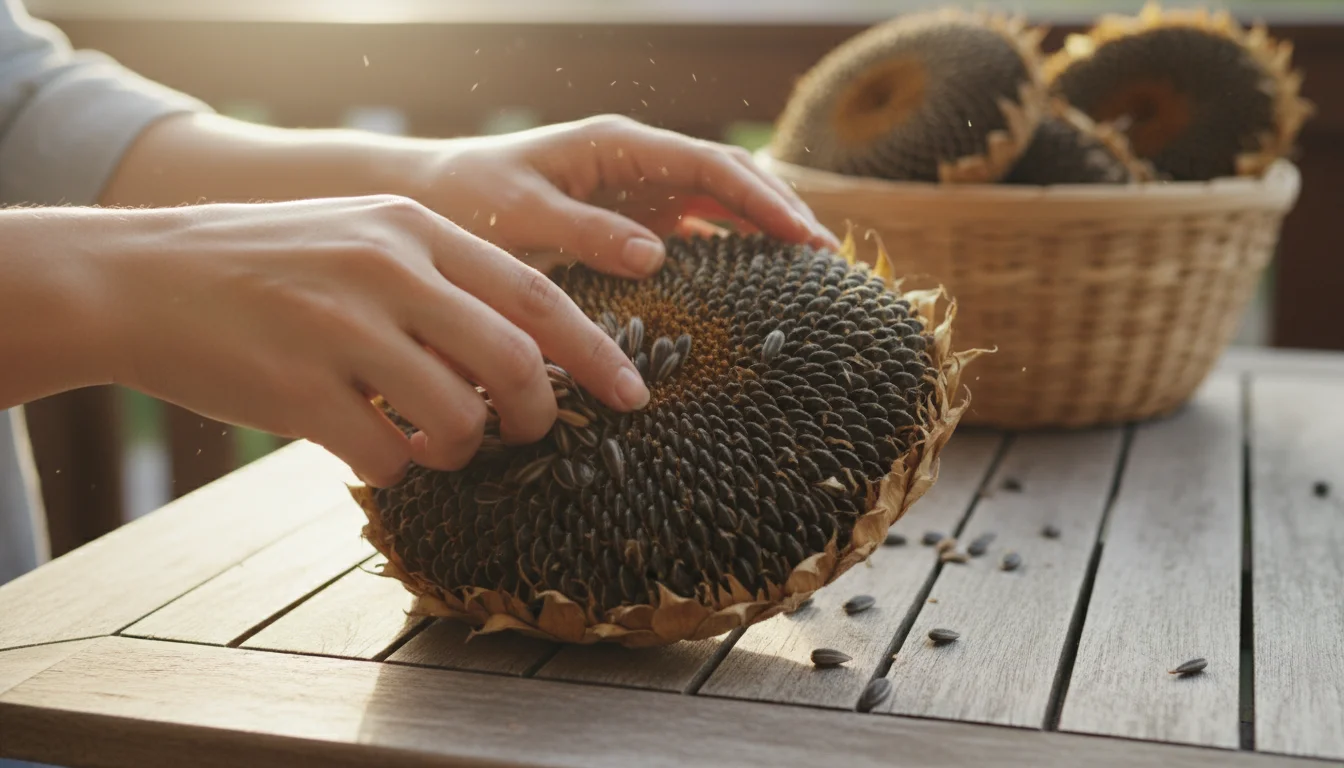
The Sustainable Harvest: Preparing Your Sunflower and Seed Heads
The beauty of this project lies in its sustainability. You use materials you already grew, effectively closing the loop in your garden’s life cycle. Knowing how to properly harvest and prepare your sunflower and other seed heads ensures your feeder will be nutritious and safe for birds. This section guides you through transforming garden “leftovers” into valuable bird sustenance.
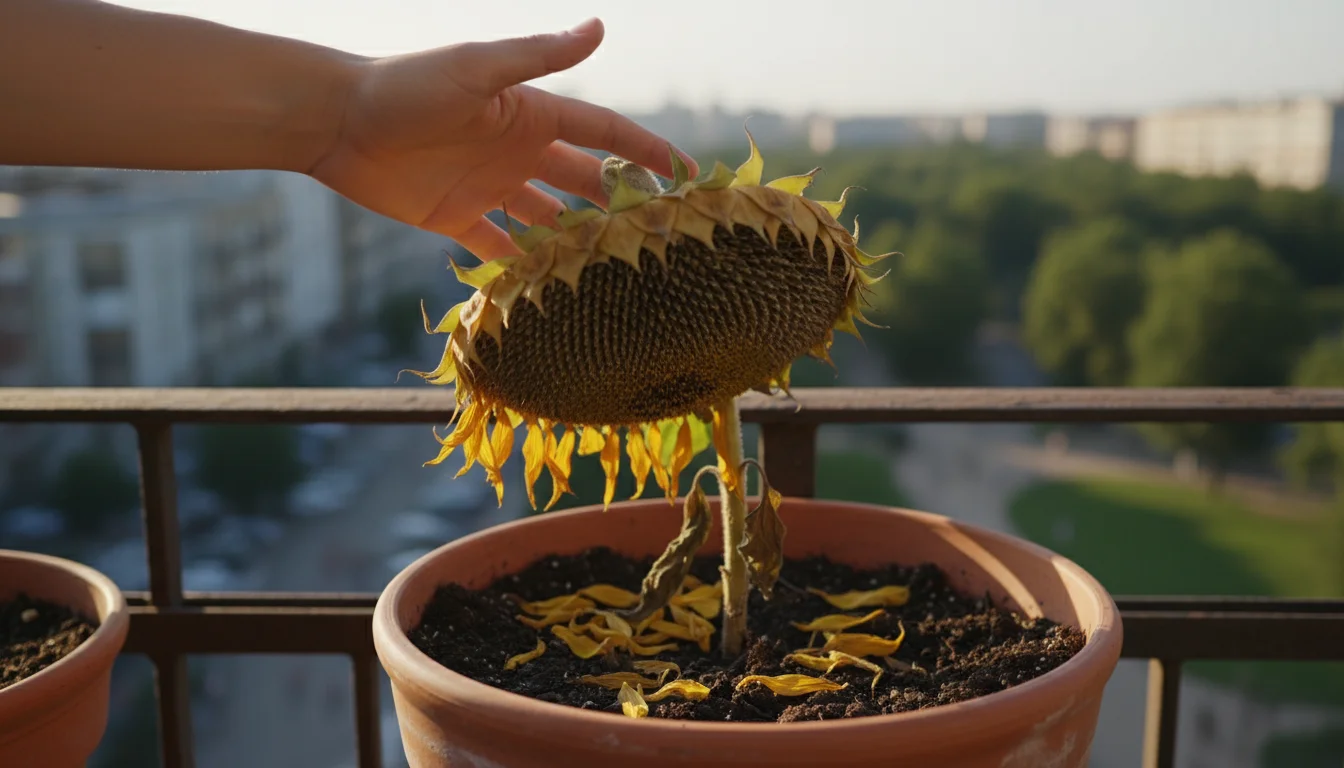
When to Harvest Sunflowers for Seeds
Timing is crucial for harvesting sunflower seeds. You want the seeds to be fully mature but not yet vulnerable to hungry squirrels or birds in your garden. Look for these signs:
- Petals Wither and Fall Off: The bright yellow petals will dry up and drop.
- Back of the Head Turns Yellow, Then Brown: The green disk behind the seed head will shift color.
- Seeds Plump and Hard: Gently inspect the seeds. They should feel full and firm in the head. Immature seeds are often soft and white.
- Head Bends Downward: A heavy, mature seed head will naturally begin to nod or hang downwards.
Often, this occurs late in the season, typically in late summer or early fall, depending on your climate and the sunflower variety. If you wait too long, natural predators might deplete your supply before you even get a chance to harvest. Some gardeners place mesh bags over the sunflower heads once they start to ripen, protecting the seeds from birds and squirrels while allowing air circulation.

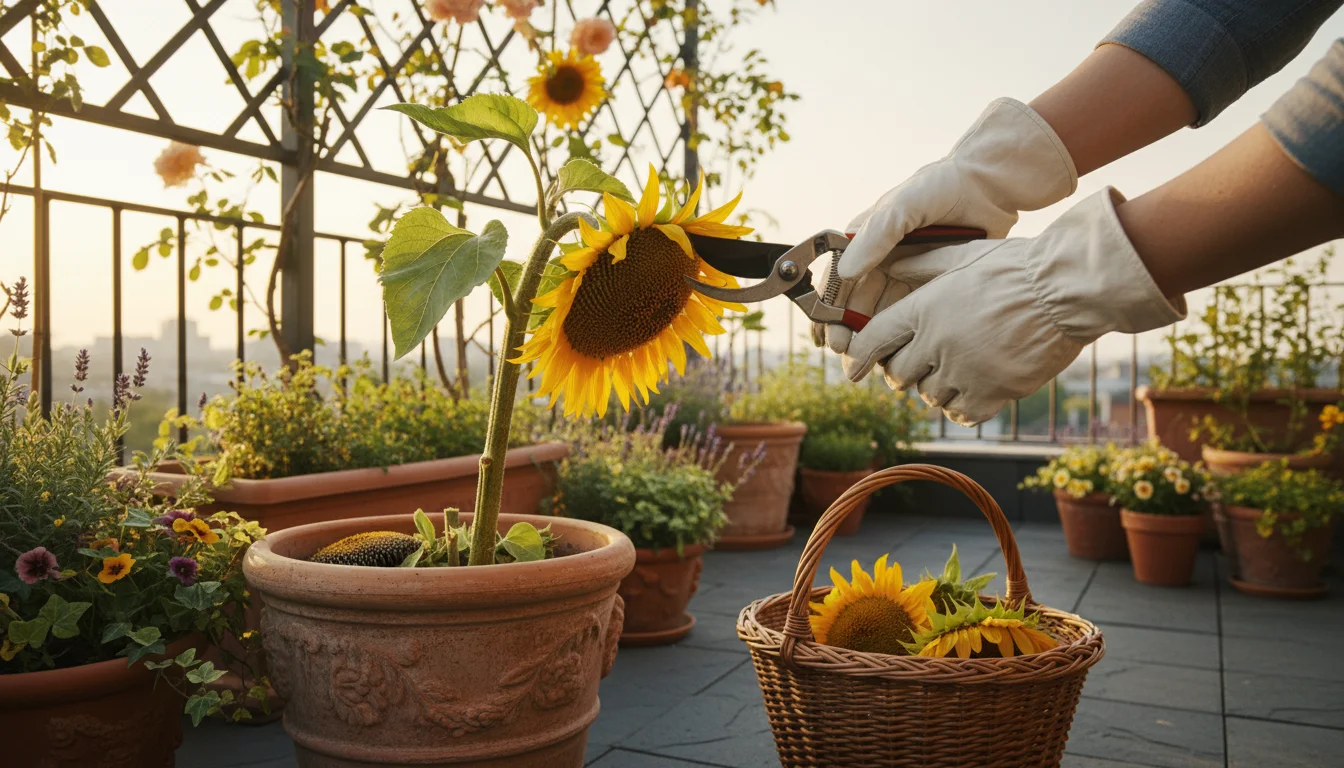
Harvesting Techniques
Once you confirm the sunflower head is ready, harvest it carefully:
- Cut with Sufficient Stem: Use sharp pruners or scissors to cut the stem about 6-12 inches below the head. This stem length gives you something to hold onto and hang the head for drying.
- Protect Your Harvest: If you are harvesting many heads, place them in a breathable basket or cloth bag to transport them indoors. Avoid plastic bags, which can trap moisture and promote mold.
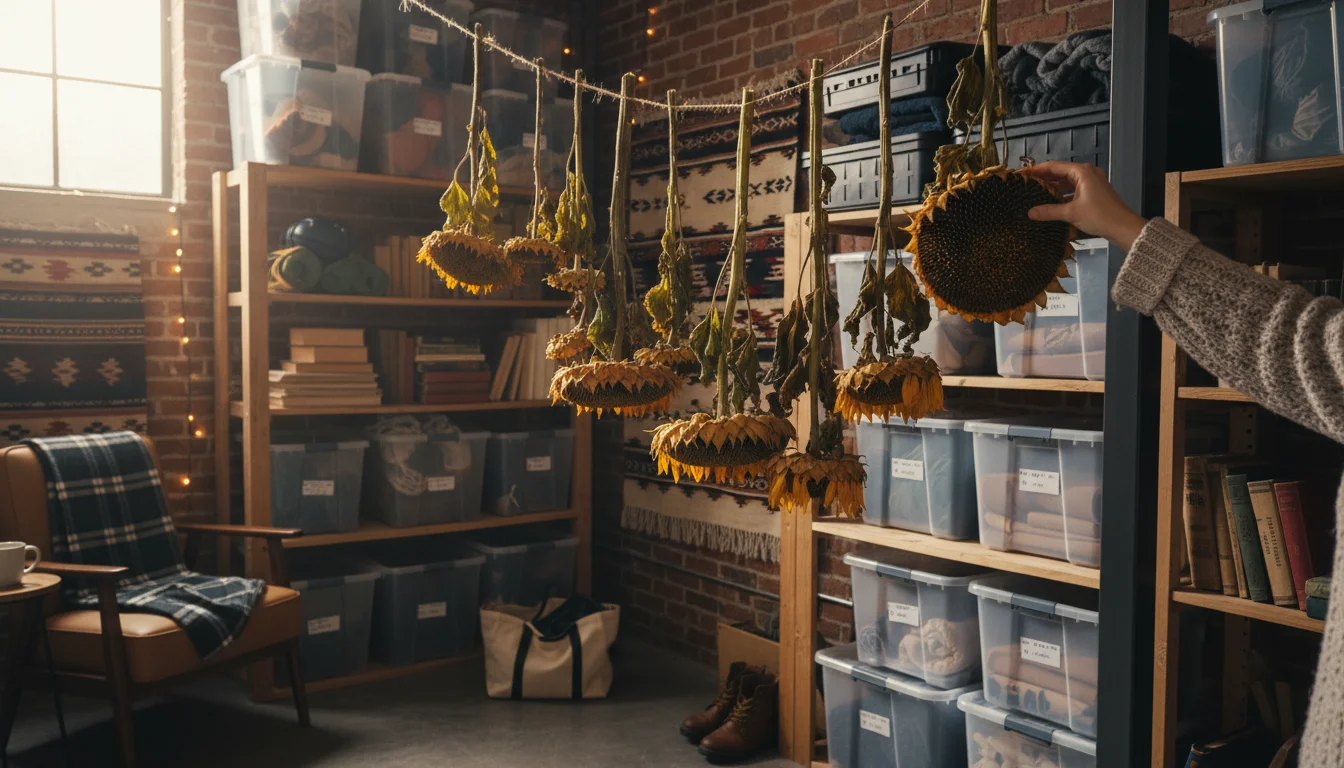
Drying and Storing Sunflower Heads
Proper drying prevents mold and ensures the seeds remain viable and healthy for birds. This step is critical for a successful and safe feeder.
- Clean Gently: Brush off any loose debris or small insects from the sunflower head. Avoid washing, as this introduces unnecessary moisture.
- Hang to Dry: Find a cool, dry, well-ventilated area indoors, such as a garage, shed, or even a closet. Hang the sunflower heads upside down by their stems. You can use string or twine to create loops for hanging. Ensure good air circulation around each head. This process usually takes 2-4 weeks, depending on humidity.
- Check for Dryness: The heads are fully dry when the seeds easily dislodge from the head and the back of the head feels completely dry and slightly brittle. The seeds themselves should be hard and dark.
- Storage (if not using immediately): Once dry, you can store the entire heads or remove the seeds. To remove seeds, rub two heads together or use a stiff brush to dislodge them. Store dried seeds in an airtight container in a cool, dark place. Whole dried heads can also be stored in breathable mesh bags.

Other Suitable Seed Heads for Your Feeder
Sunflowers are a fantastic choice, but many other plants in your garden produce seeds birds love. Incorporating a variety offers different nutrients and attracts a wider range of species. Look for these possibilities:
- Coneflowers (Echinacea): Their spiky centers hold numerous seeds that finches adore.
- Black-Eyed Susans (Rudbeckia): Similar to coneflowers, these offer small, nutritious seeds.
- Millet: Often found in ornamental grasses, millet is a favorite of small songbirds.
- Cardinal Flower (Lobelia cardinalis): Produces tiny seeds favored by some birds.
- Zinnias: While less common for direct feeding, some birds will pick at dried zinnia seeds.
Follow the same drying principles for these seed heads: harvest when mature and dry thoroughly in a well-ventilated space to prevent mold.
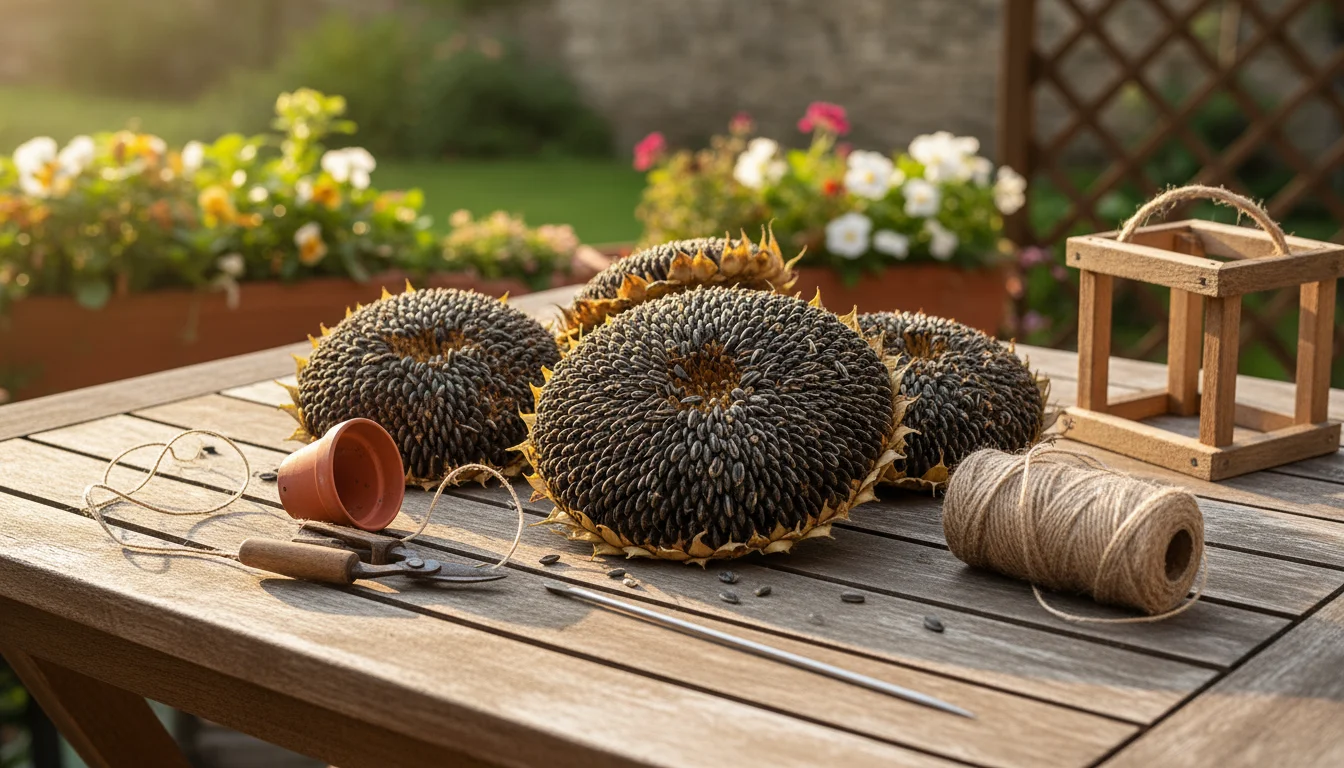
Gathering Your Crafting Toolkit: Materials You’ll Need
Creating your bird feeder involves a few simple tools and materials, most of which you likely already have or can easily acquire. This project champions repurposing and natural elements, keeping the process straightforward and eco-friendly.
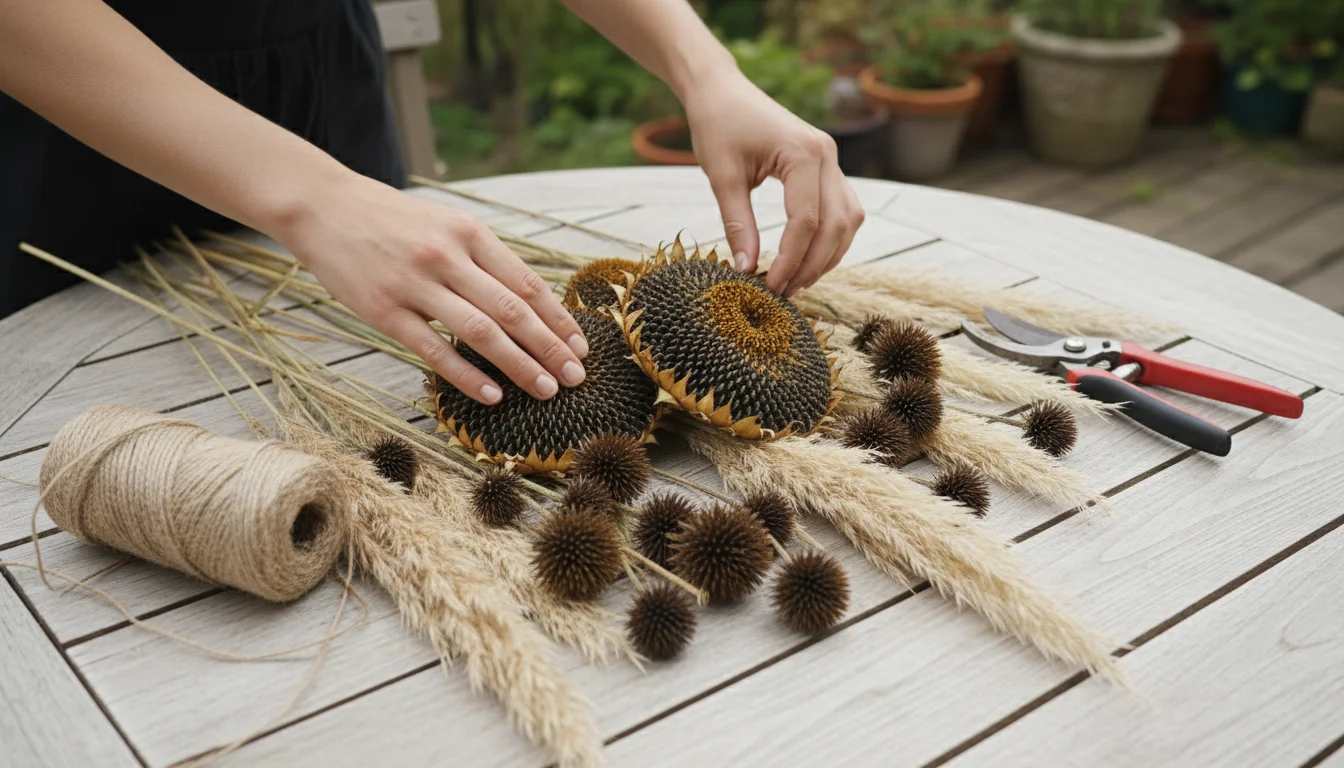
Essential Materials:
- Dried Sunflower Heads: The star of your feeder. Ensure they are thoroughly dried as described in the previous section. You might use 1-3 heads per feeder, depending on their size and your design.
- Other Dried Seed Heads (Optional): Coneflowers, ornamental grasses, black-eyed Susans add variety.
- Natural Twine or Jute String: Choose a strong, biodegradable material. Avoid synthetic strings, which can fray and pose entanglement risks to birds. About 1-2 feet per feeder will be sufficient, depending on your hanging preferences.
- Sharp Scissors or Garden Pruners: For cutting stems and twine.
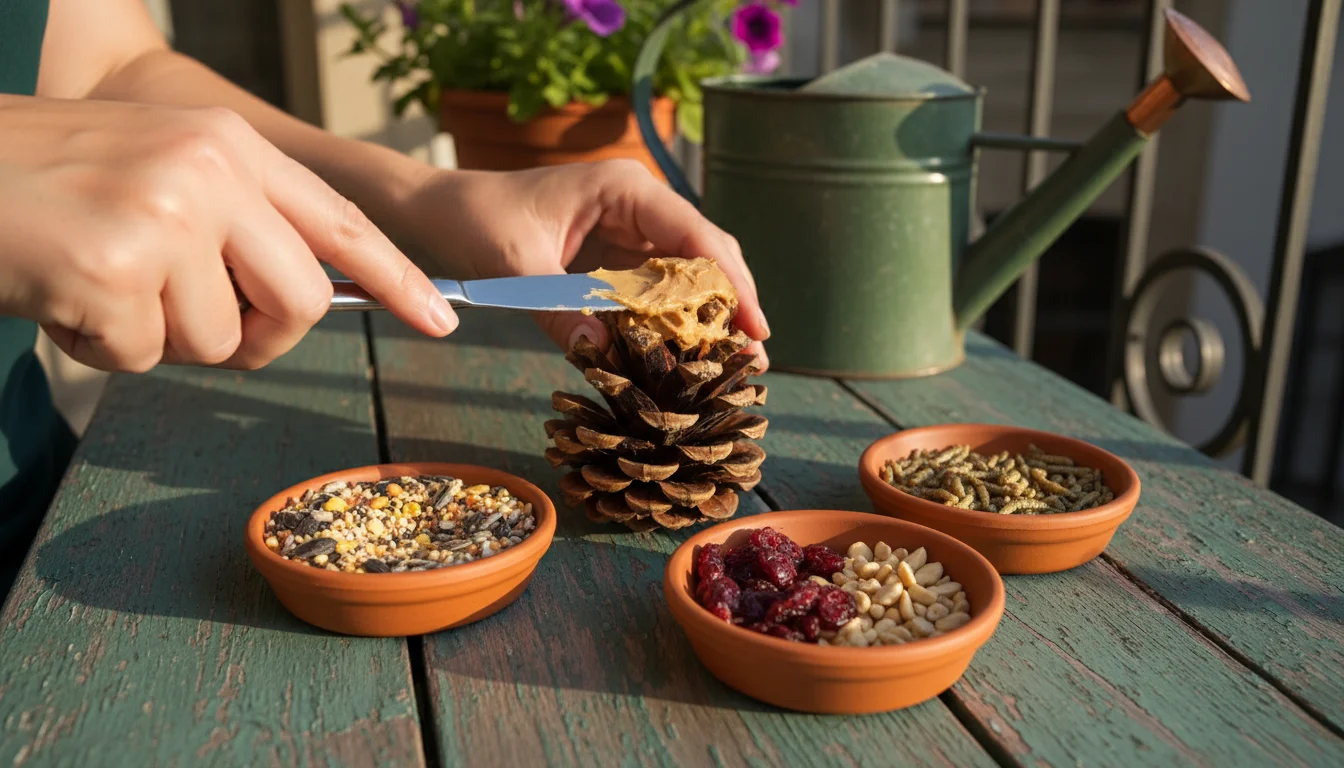
Optional Materials for Enhanced Feeders:
- Biodegradable Wire (Optional): For creating more durable hanging loops or securing elements. Look for rust-resistant options if possible.
- Peanut Butter (Unsweetened, Unsalted) or Suet: A high-energy treat for birds, especially beneficial in colder months. Ensure it contains no xylitol, which is toxic to animals.
- Mixed Birdseed: If you want to augment your natural seeds, a good quality mix can attract a broader range of birds.
- Pinecones: Excellent for smearing with peanut butter and rolling in loose birdseed, creating additional feeding surfaces.
- Dried Berries or Small Fruits: Cranberries, raisins (avoid grapes for pets), or chopped dried apples can offer additional nutritional value and attract specific bird species.
- Drill with Small Bit (Optional): If you want to create more secure hanging points in very dense sunflower heads.
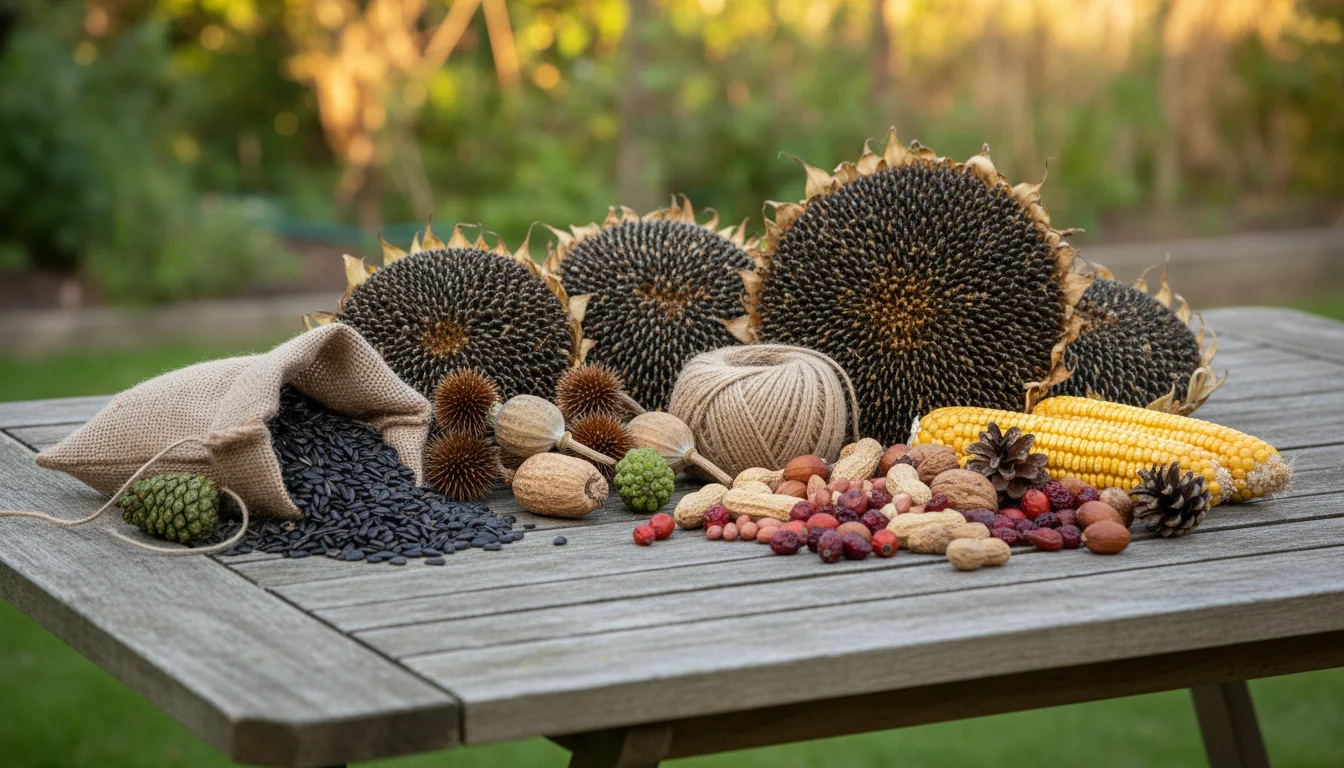
Where to Source Materials:
The beauty of this project is that your garden provides the main components. For twine, visit your local garden center, hardware store, or craft shop. Many stores carry natural jute or sisal twine. If you use peanut butter or suet, check your pantry for unsalted, unsweetened varieties. Your local pet supply or garden store will carry bird-friendly suet blocks or general mixed birdseed. By sourcing from your own garden and repurposing household items, you reduce cost and environmental impact.
Always prioritize natural, untreated, and non-toxic materials. Avoid anything painted, chemically treated, or made of plastics that can degrade into microplastics. You want your feeder to be safe and beneficial for your feathered visitors.
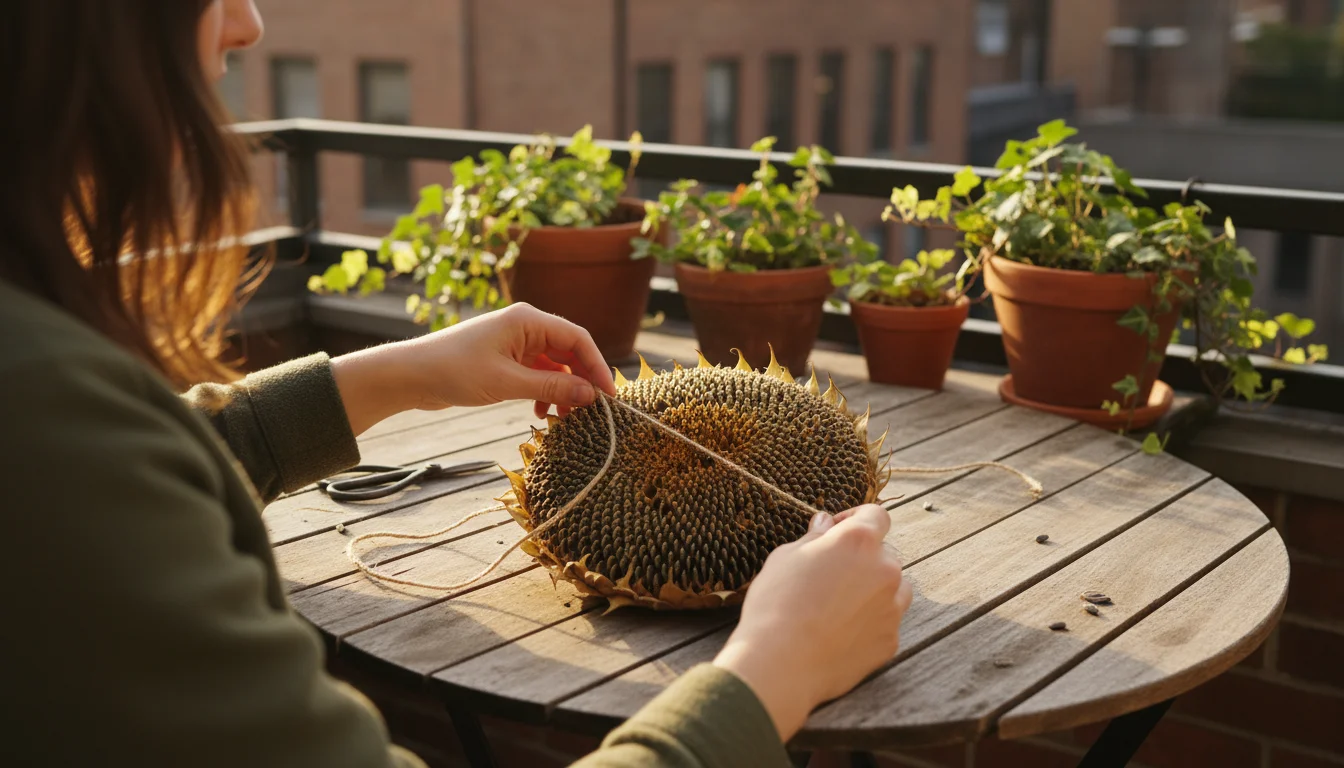
Step-by-Step: Crafting Your Natural Bird Feeder
Now that you have your materials, let us turn those garden treasures into inviting bird feeders. This section provides detailed instructions for several types of natural feeders, from the simplest sunflower head design to more elaborate, combined structures. You can choose the method that best suits your materials and crafting comfort level.

Method 1: The Simple Whole Sunflower Head Feeder
This is the easiest and most direct way to use your dried sunflower heads. Birds naturally love to pick seeds directly from the head.
- Select Your Sunflower Head: Choose a well-dried sunflower head with plenty of seeds. If you removed the stem during drying, that is perfectly fine.
- Prepare the Hanging Loop:
- If your sunflower head has a good, sturdy stem remaining (6+ inches), simply tie a loop of natural twine around the stem, securing it with a strong knot. Ensure the loop is large enough to hang easily.
- If the stem is short or absent, you have two options:
- Drill a Hole (Optional, but recommended for security): Using a small drill bit (1/8 to 1/4 inch), carefully drill one or two holes through the fibrous base of the sunflower head, near the top edge. Thread a piece of twine through these holes and tie a secure loop. This provides a very stable hanging point.
- Wrap Around: If you prefer not to drill, wrap a strong piece of twine around the entire circumference of the sunflower head, securing it tightly. This method works, but ensure it does not easily slip off as birds perch and feed.
- Hang Your Feeder: Find a suitable spot on your balcony or in your yard (more on this later). Hang the feeder securely. Birds will then perch on the head and extract the seeds themselves.
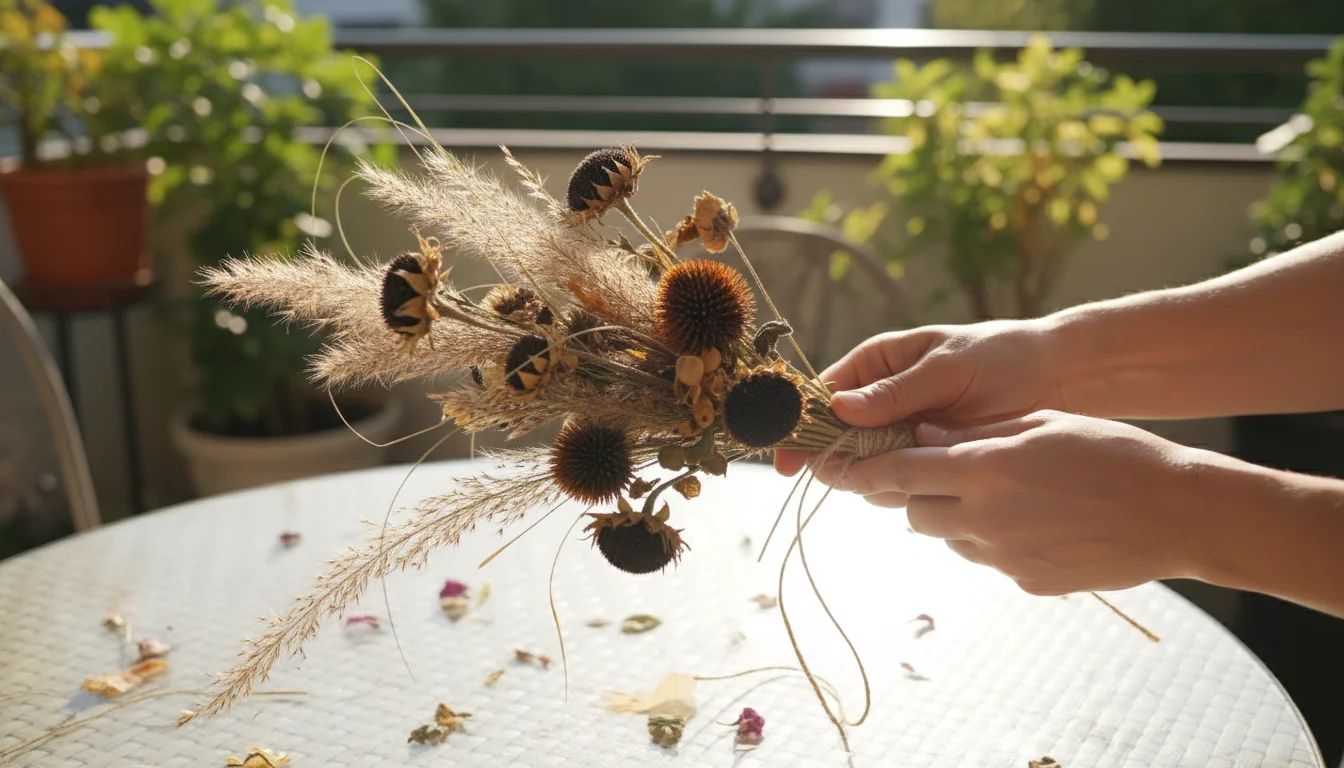
Method 2: Seed Head Bundles for Variety
This method allows you to combine various dried seed heads, creating a diverse buffet for different bird species.
- Gather Your Seed Heads: Collect a variety of dried seed heads such as smaller sunflower heads, coneflowers, black-eyed Susans, or ornamental grasses.
- Arrange the Bundle: Group 3-5 seed heads together, holding them by their stems. Try to arrange them so the seed-bearing parts are accessible. You can intersperse a small sunflower head with a few coneflower heads, for example.
- Tie Securely: Using your natural twine, wrap it tightly around the stems of the bundle, about 2-3 inches below the seed heads. Create a very firm knot to hold everything together. Leave a long tail of twine.
- Form the Hanging Loop: Use the long tail of twine to create a hanging loop above the bundle, securing it with another strong knot. Ensure the loop is strong enough to bear the weight of the bundle and feeding birds.
- Optional: Add Supplementary Seeds: For a quick boost, you can gently rub a small amount of unsalted peanut butter onto some of the more fibrous seed heads, then press loose birdseed onto the peanut butter.
- Hang Your Bundle: Place your seed head bundle in a visible yet protected spot for birds to discover.

Method 3: Suet-Coated Seed Heads (Winter Boost)
This method adds a high-energy fat source, invaluable for birds during cold winter months. This works particularly well with pinecones, but you can also use denser sunflower head bases or other sturdy seed structures.
- Prepare Your Base: Choose a dried sunflower head (you can break off the outer ring of seeds if you prefer), a sturdy pinecone, or a dense cluster of seed heads. Make sure it has a way to hang.
- Create a Hanging Loop: For pinecones, simply tie twine securely around the top scales, forming a loop. For sunflower heads, use Method 1’s drilling or wrapping technique to establish a strong hanging point.
- Prepare the Suet/Peanut Butter Mixture:
- For Peanut Butter: Use unsalted, unsweetened peanut butter. It should be thick enough to stick.
- For Homemade Suet (optional): Melt beef suet (rendered fat) gently over low heat. Once melted, you can mix in birdseed, chopped nuts, or dried fruit. Let it cool slightly until it is thick but still pliable.
- Coat the Seed Head/Pinecone:
- With Peanut Butter: Use a butter knife or small spatula to spread a generous layer of peanut butter into the crevices of the pinecone or onto the base of the sunflower head. Ensure it is firmly pressed in.
- With Suet Mixture: Press the warm, pliable suet mixture into the crevices. Be careful not to burn yourself.
- Roll in Birdseed (Optional): If you are using peanut butter, roll the coated pinecone or seed head in a tray of mixed birdseed. The seeds will stick to the peanut butter, making it even more attractive and nutritious for birds.
- Chill (for Suet): If using suet, you might want to chill the feeder in the refrigerator for an hour or two to help the suet firm up before hanging.
- Hang Your Energy Feeder: Place this feeder where birds can easily access it. The high-fat content makes it particularly useful during cold weather.

Placing Your Feeder: Best Spots for Balcony Birds
Where you place your bird feeder significantly impacts its success in attracting birds and ensuring their safety. For balcony gardeners, location involves specific considerations related to limited space, urban environments, and potential hazards.
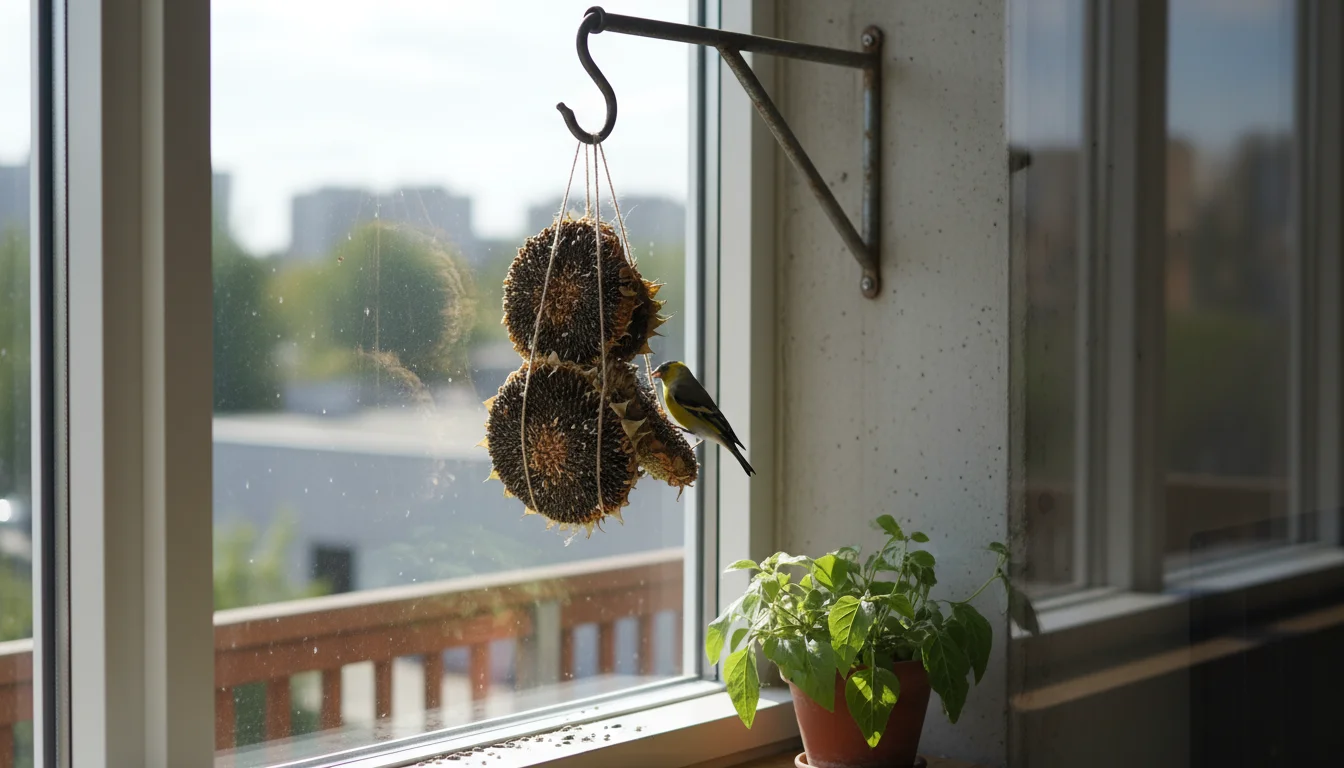
Safety First: Protecting Birds from Predators and Collisions
The primary goal is to provide a safe haven, not a hazard. Consider these points:
- Away from Predators: Position your feeder where neighborhood cats cannot easily ambush birds. This often means hanging it from a sturdy hook that extends away from ledges or railings, preventing a cat from jumping onto the feeder. If you have a cat, ensure it cannot access the feeder area.
- Window Collision Prevention: Birds might collide with windows, especially reflective ones. Research indicates that placing feeders either very close (within 3 feet) or very far (over 30 feet) from windows reduces collisions. For a balcony, “very close” is usually your best option. A feeder placed directly on or very near the glass allows birds to see the window and avoid high-speed impact. Alternatively, applying window decals or screens can help birds perceive the glass.
- Shelter and Escape Routes: Birds feel safest when they have quick access to cover. If your balcony has potted shrubs, small evergreens, or dense vining plants, place the feeder somewhat near these. This provides a convenient escape route if a predator appears.
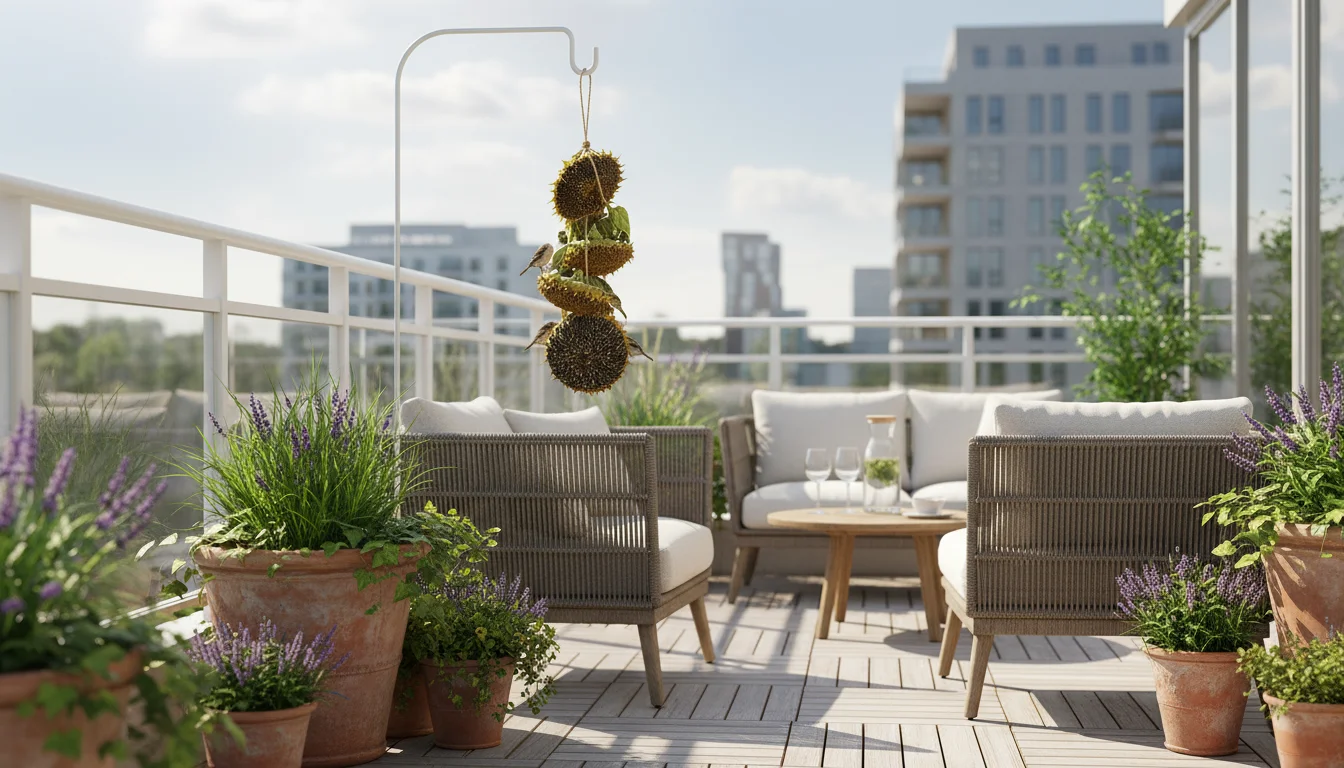
Visibility and Accessibility for Birds (and You)
You want the birds to find the feeder, and you want to enjoy watching them.
- Clear Sightlines: Birds prefer an open approach to a feeder, allowing them to spot potential dangers. Avoid placing it deep within dense foliage where visibility is poor.
- Out of High Traffic: While you want to see the birds, too much human activity directly next to the feeder might deter shy species. Find a balance between your viewing pleasure and the birds’ comfort.
- Accessibility for Different Birds: Consider how different birds will use the feeder. Smaller songbirds often prefer hanging feeders that swing slightly. Larger birds might need a more stable perch. Your natural seed head feeders are generally accessible to a wide range of small and medium-sized birds.
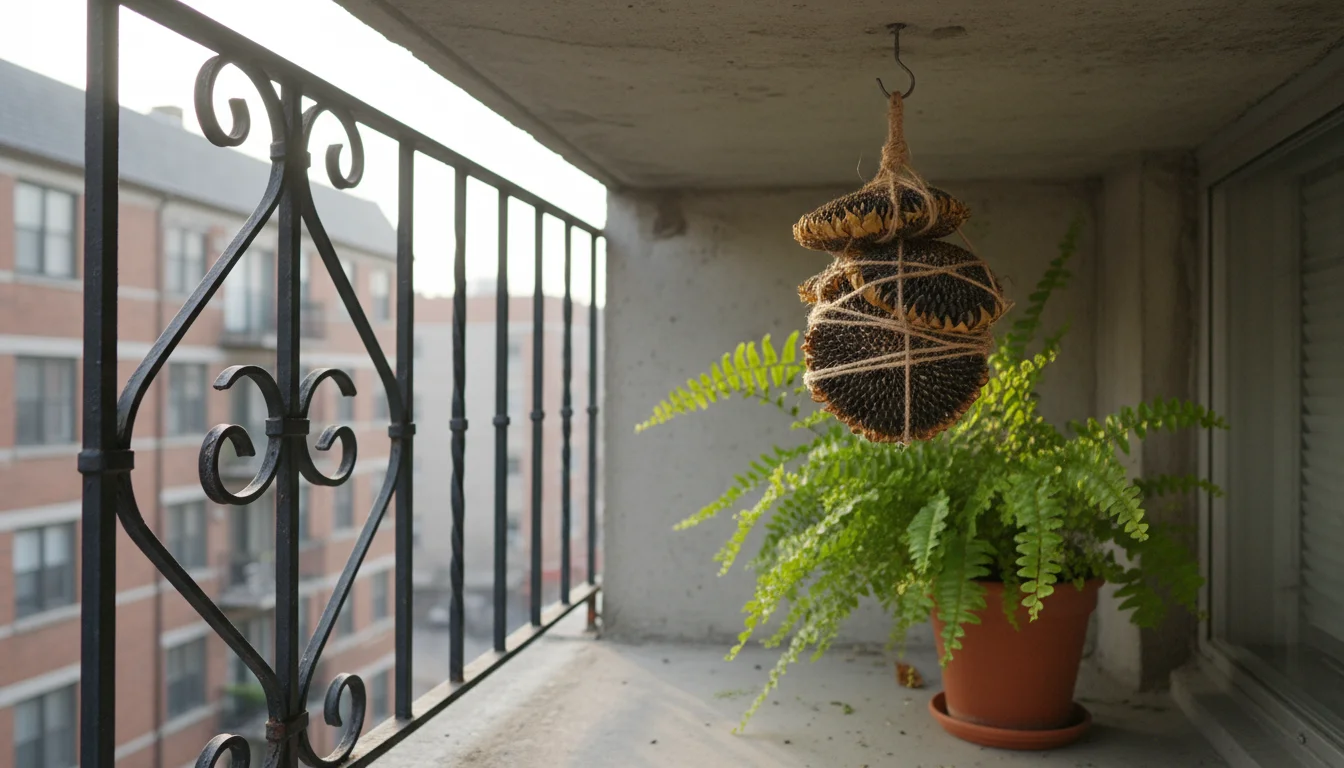
Protection from Elements
Your feeder, being made of natural materials, needs some protection from harsh weather to last longer and prevent seed spoilage.
- Rain and Snow: Try to hang your feeder under an awning, balcony above, or a small overhang. Consistent rain saturates natural feeders, promoting mold growth and causing seeds to rot. If your feeder gets wet, bring it in to dry completely.
- Strong Winds: High winds can dislodge feeders, scatter seeds, and make it difficult for birds to feed. Choose a spot that is somewhat sheltered from the prevailing wind direction on your balcony.
- Sun Exposure: While some sun is fine, prolonged direct sun can dry out some suet mixtures too quickly or cause peanut butter to go rancid faster. Balance sun exposure with protection.
Regularly check your chosen spot. Observe how wind, sun, and rain affect the feeder. Adjust its placement as needed to optimize conditions for your feathered visitors.
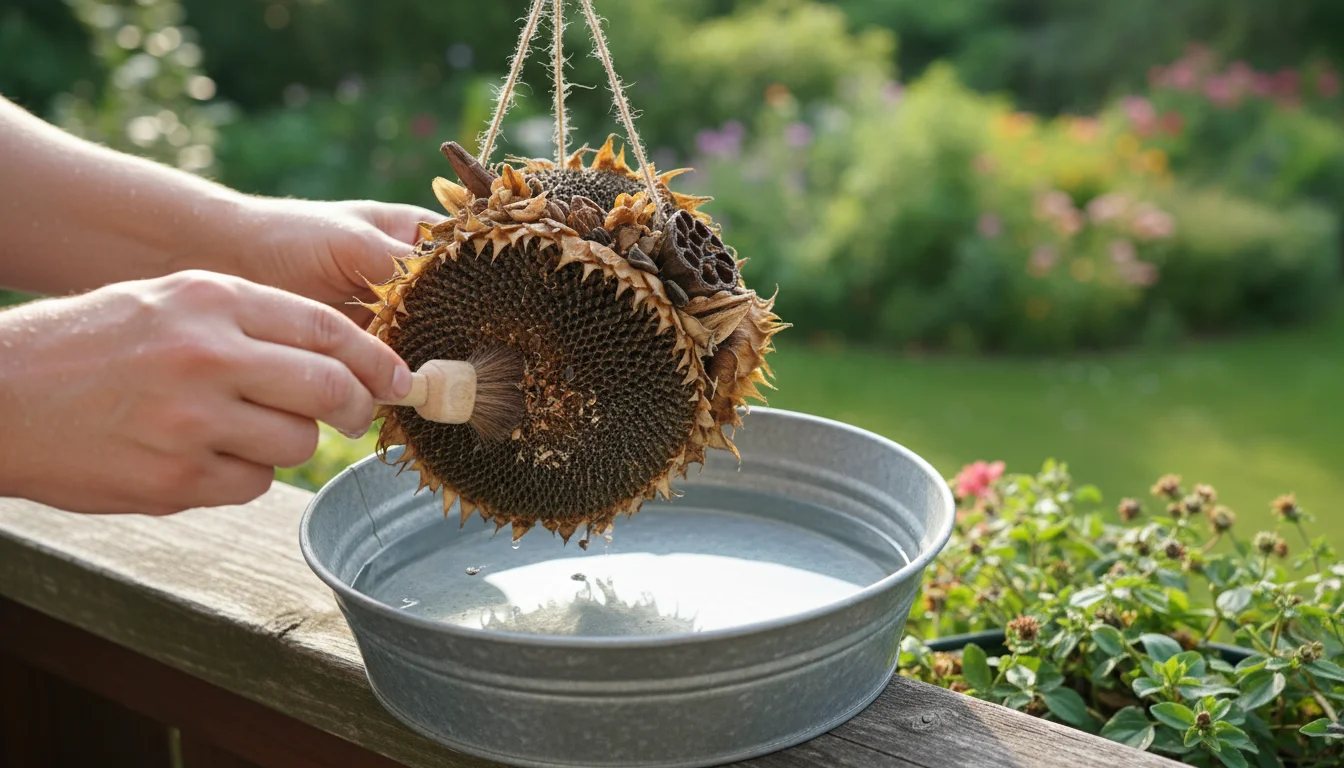
Maintenance and Care: Keeping Your Feeder Clean and Safe
A natural bird feeder made from garden materials offers a charming, rustic appeal, but it also requires attentive maintenance to ensure it remains a healthy and safe food source for birds. Neglecting feeder hygiene can inadvertently spread diseases among bird populations. This section outlines how to keep your upcycled feeder in top condition.

Regular Inspection and Cleaning
Unlike plastic or metal feeders, natural feeders can degrade more quickly and harbor moisture, leading to mold or bacterial growth. Regular checks are essential.
- Daily Visual Check: Glance at your feeder each day. Is it looking sparse? Are there any signs of mold, mildew, or insect activity? Is the twine secure?
- Weekly Deep Clean (or more often if needed):
- Remove Old Materials: Take down the feeder. If it is a sunflower head, gently brush off any remaining loose seeds or debris. For seed head bundles, remove any visibly decaying parts.
- Discard as Needed: Since these feeders are natural, they will not last indefinitely. If you see significant mold, rot, or if the structure becomes flimsy, it is time to compost or discard the feeder and replace it with a new one. This is part of the sustainable cycle of this project.
- Sanitize (Optional for non-compostable parts): If you used reusable components (like a wire hanger that is cleanable), you can wash them in a solution of one part bleach to nine parts water, rinse thoroughly, and let them air dry completely before reuse. However, for the seed heads themselves, disposal and replacement are usually the best and safest approach.
- Why Cleanliness Matters: Birds can transmit diseases at feeders, especially through contaminated food and droppings. Pathogens like salmonella can spread rapidly. By providing clean food and surfaces, you minimize this risk, supporting healthy bird populations.

Managing Moisture and Spoilage
Moisture is the enemy of natural feeders.
- Keep it Dry: Position your feeder to avoid direct rain and snow as much as possible. A spot under an overhang or a deeper part of your balcony works best.
- Rotate and Replace: Natural seed heads will eventually break down. Do not expect them to last as long as commercial feeders. Aim to replace your feeder every 2-4 weeks, or sooner if it gets very wet or shows signs of spoilage. This ensures fresh, uncontaminated food is always available.
- Smaller Quantities: Instead of loading one giant sunflower head, you might use smaller ones or bundles, replacing them more frequently. This prevents large amounts of seeds from spoiling simultaneously.
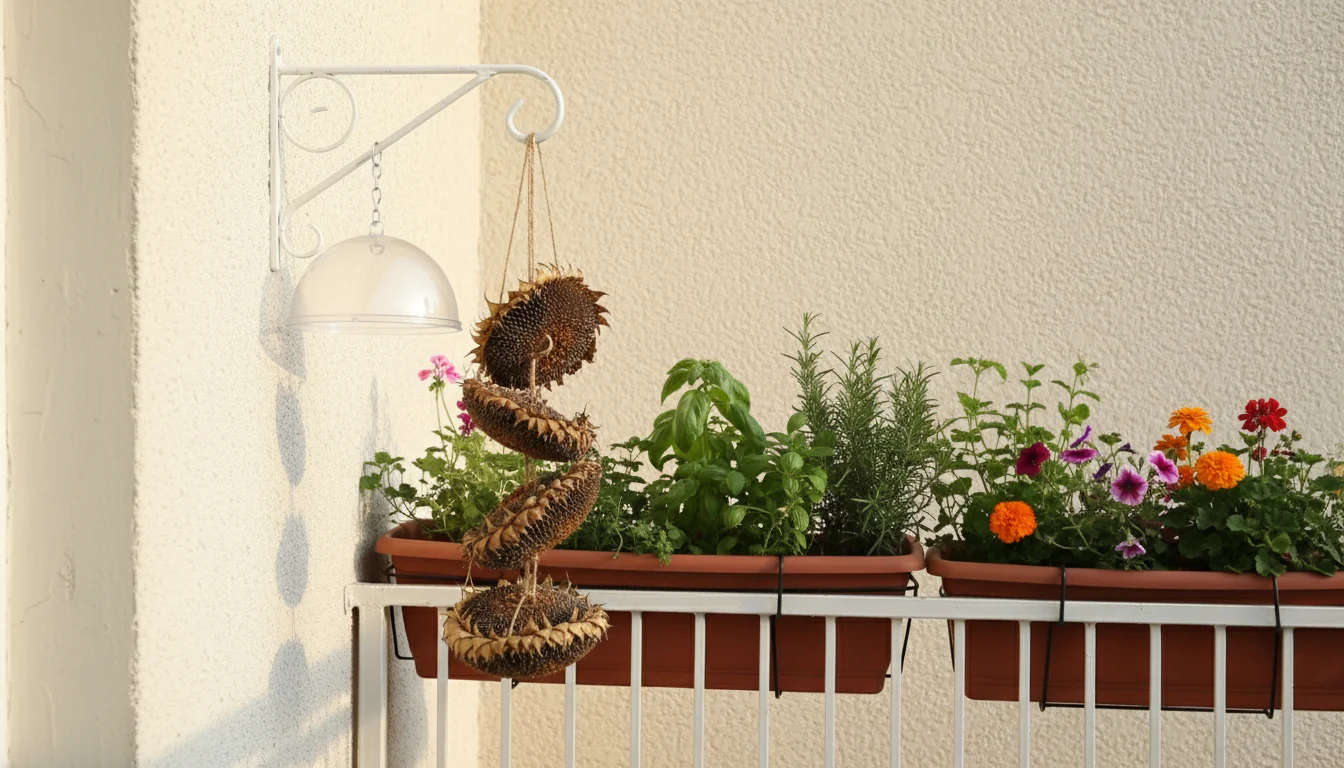
Pest Control
Bird feeders can inadvertently attract unwanted visitors. Your balcony environment presents specific challenges.
- Squirrels: Squirrels are persistent. No feeder is entirely squirrel-proof, but you can deter them.
- Placement: Hang feeders away from railings, tree branches, or other jumping-off points. Give them at least 5-6 feet of clear space around the feeder if possible.
- Baffles: While harder on a balcony, you could install a squirrel baffle (a dome or cone-shaped barrier) above or below the feeder if you have a suitable hook or pole.
- Distraction: Sometimes, providing a separate squirrel feeder with corn or peanuts far from your bird feeder can keep them occupied.
- Insects (Ants, Wasps): Sweet or fatty offerings like peanut butter can attract insects.
- Ant Moats: If ants are a problem, you can buy or make an ant moat (a small container of water hung above the feeder) to block their path.
- Clean Up Spills: Promptly clean up any spilled seeds or food that drops onto your balcony floor, which can attract ants or cockroaches.
- Rodents (Rats, Mice): In urban areas, unattended seed can attract rodents.
- Evening Removal: If you suspect rodent activity, consider bringing your feeder in at dusk and putting it back out in the morning.
- Cleanliness: Ensure no seeds accumulate on the ground below the feeder. Regular sweeping and cleaning are your best defense.
By staying vigilant with inspection and cleaning, and adapting to any pest issues, you ensure your natural bird feeder remains a healthy and happy stop for your feathered visitors. Your commitment to maintenance is a commitment to the well-being of local wildlife.
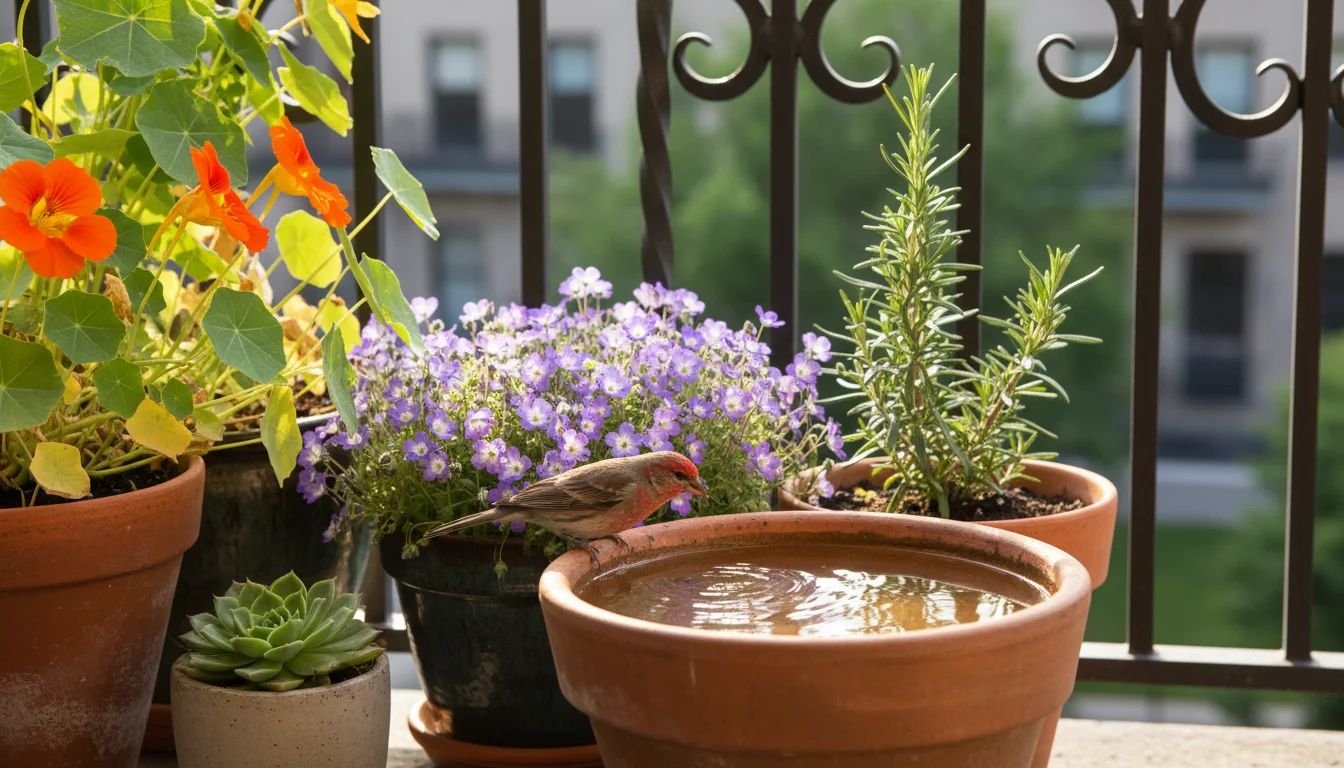
Expanding Your Balcony Bird Haven: Companion Plants and Water Sources
A bird feeder is a fantastic start, but to truly transform your balcony into a vibrant wildlife haven, you should think beyond just food. Providing water and shelter through companion planting creates a more comprehensive and attractive habitat for birds, encouraging them to linger and even nest in your small space. This holistic approach maximizes your ecological impact.
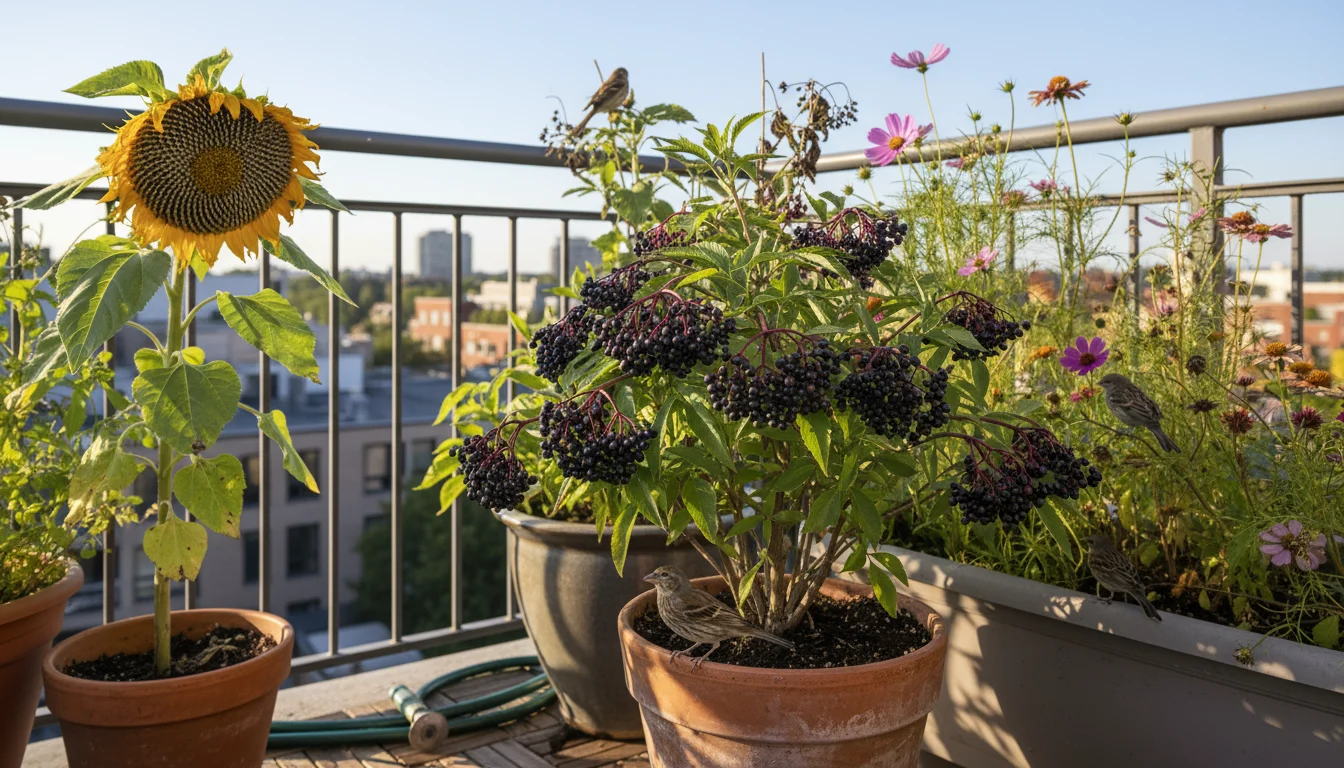
Strategic Planting for Birds
Even on a balcony, you can choose plants that offer additional food, nesting sites, and protection. Focus on native plants whenever possible, as they are best adapted to your local ecosystem and provide the most benefit to native bird species.
- Berry-Producing Shrubs: While large shrubs might be challenging, dwarf varieties or those suitable for containers offer valuable food.
- Serviceberry (Amelanchier species): Some dwarf varieties grow well in large pots and produce berries birds love.
- Elderberry (Sambucus species): Again, look for compact cultivars that yield berries.
- Nandina (Nandina domestica): Often called “Heavenly Bamboo,” some varieties produce red berries. Check if it is considered invasive in your region.
- Seed-Bearing Perennials: Beyond sunflowers and coneflowers, many flowering plants produce seeds birds will consume.
- Coreopsis (Tickseed): Small, abundant seeds.
- Rudbeckia (Black-Eyed Susans): Excellent for finches.
- Asters and Goldenrod (Solidago species): Provide late-season seeds and attract insects, which birds also eat.
- Ornamental Grasses: Many varieties offer seeds and valuable cover.
- Nectar Plants: While feeders are about seeds, nectar plants attract hummingbirds and insect-eating birds indirectly by drawing in insects.
- Trumpet Vine (Campsis radicans) or Honeysuckle (Lonicera species): If you have a trellis, these vines attract hummingbirds.
- Bee Balm (Monarda species): Attracts hummingbirds and pollinators, whose larvae birds might eat.
- Salvia: Many varieties offer nectar.
- Evergreens for Shelter: Even small evergreen shrubs or conifers in containers provide crucial winter shelter and nesting sites.
- Dwarf Conifers: Many varieties remain compact and offer dense cover.
- Boxwood (Buxus sempervirens): A classic for small spaces, offering dense green foliage.
When selecting plants, consider mature size, sun requirements of your balcony, and the size of your containers. Use good quality potting mix (soil designed for containers, which drains well) and ensure adequate drainage holes in all your pots to prevent waterlogging.
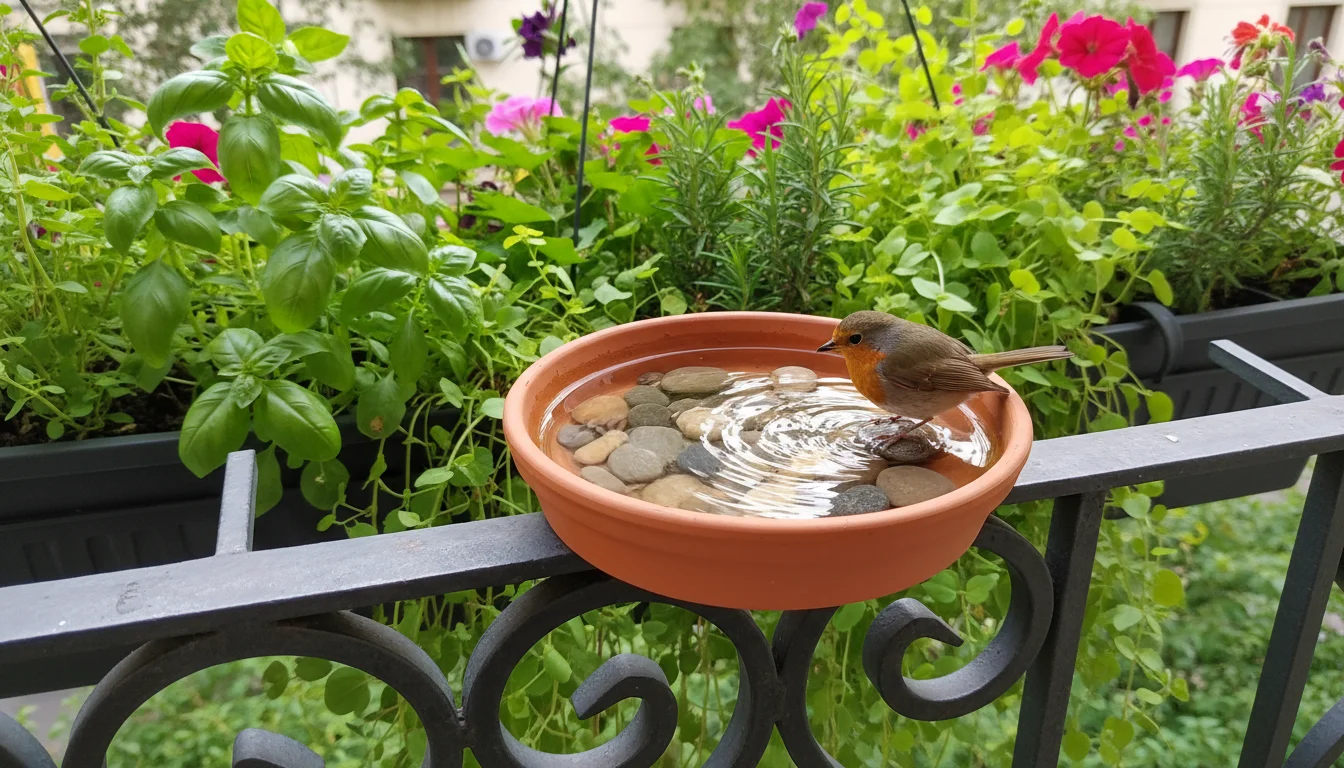
The Importance of a Water Source
Birds need water for drinking and bathing. A consistent, clean water source can attract more birds than a feeder alone. It is a critical component of any wildlife-friendly garden.
- Simple Bird Bath: Even a shallow dish filled with water works.
- Shallow is Key: Birds prefer shallow water, no more than 1-2 inches deep at its deepest point. You can place stones in a deeper dish to create varying depths.
- Rough Surface: Birds like to grip, so a bird bath with a textured bottom or added stones is better than a slick surface.
- Placement: Place the bird bath near your feeder and shelter plants, but not so close that splashing contaminates the feeder. Keep it visible for you to enjoy and for birds to spot.
- Cleanliness: Change the water daily and scrub the bird bath every few days to prevent algae and bacterial growth. Clean water is just as important as clean food.
- Moving Water (Optional): Birds are highly attracted to the sound and movement of water. Small, solar-powered bubblers or drippers can be added to a shallow dish, though this is a more advanced option for balcony setups.
By providing food, water, and shelter, you create a complete habitat that supports birds throughout the year. Your balcony becomes a vibrant ecosystem, demonstrating that small spaces can yield big environmental benefits.
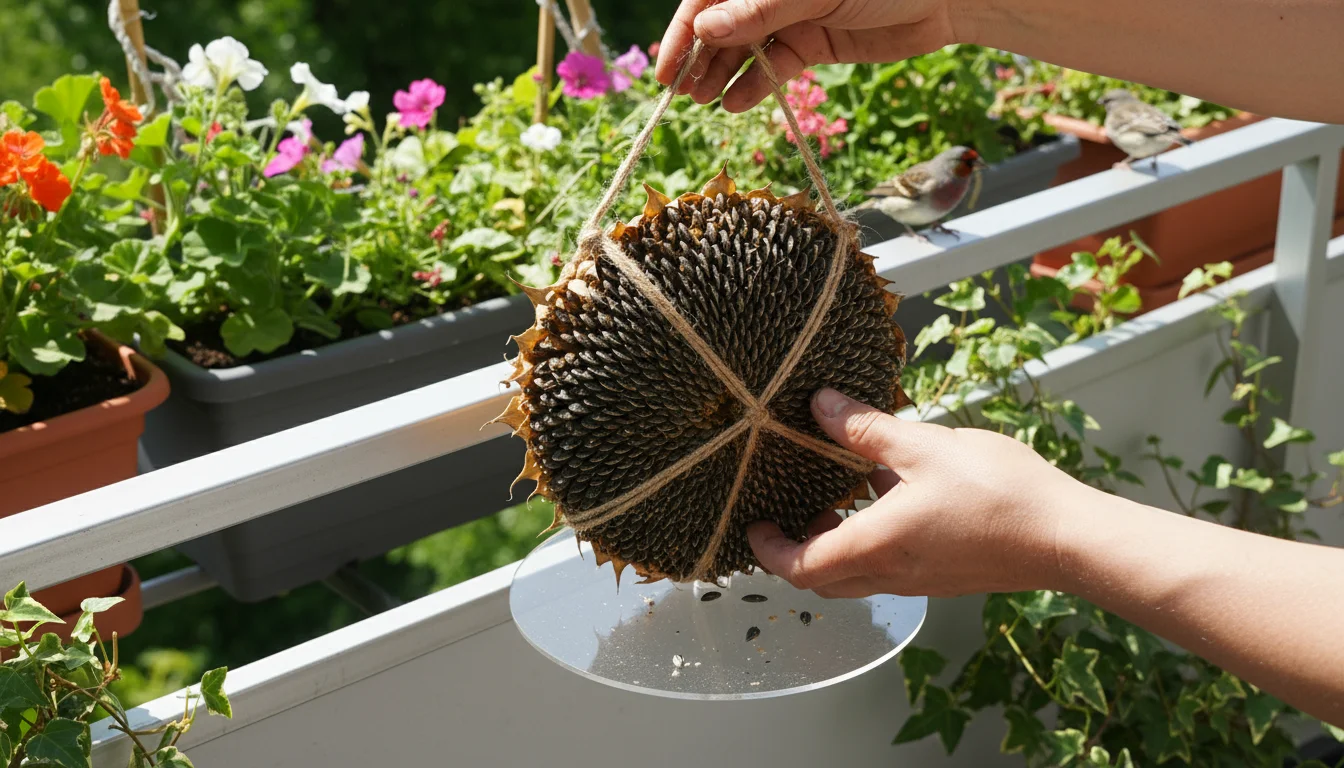
Troubleshooting Common Balcony Bird Feeder Challenges
Even with the best intentions, you might encounter a few hurdles when trying to establish a balcony bird feeder. Do not get discouraged. Many common problems have simple solutions. Here is how to address some typical challenges.
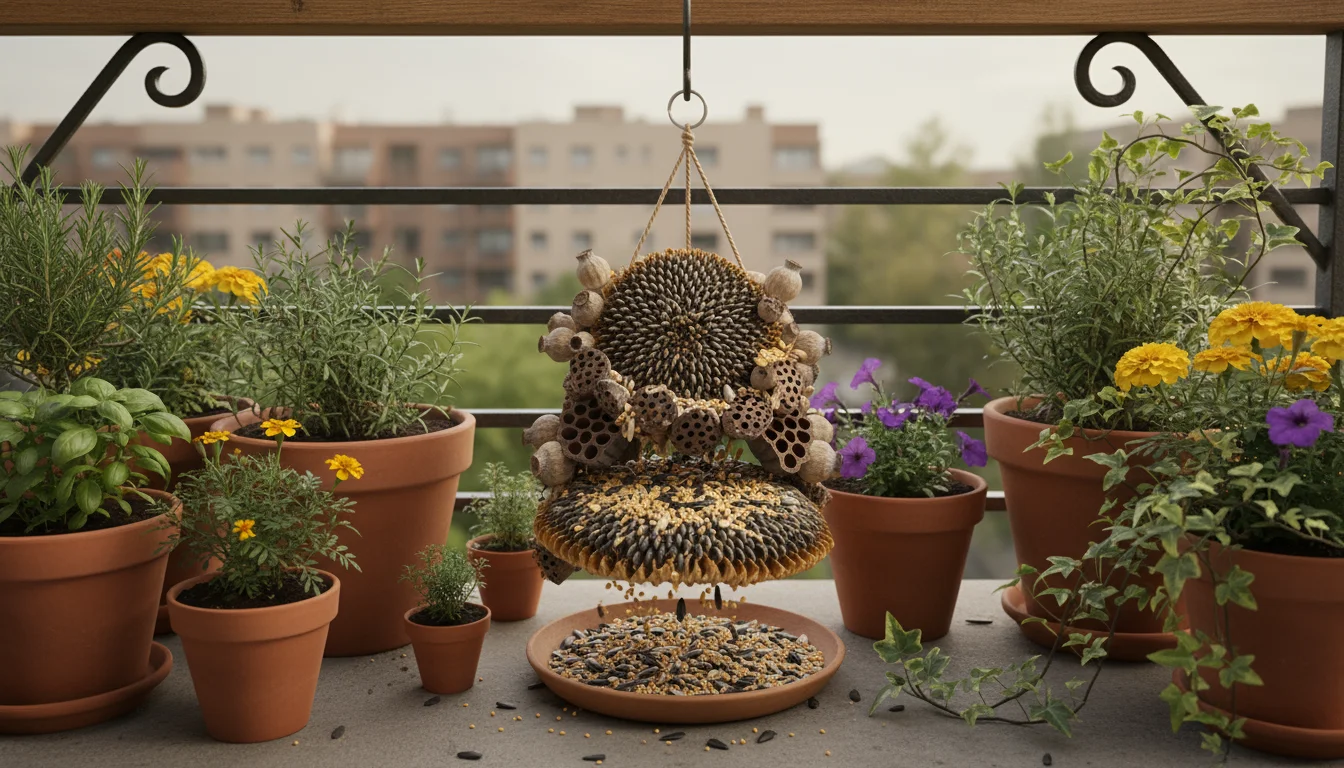
“Why are no birds coming to my feeder?”
This is a common question, especially for new feeders. Patience is a virtue when attracting wildlife.
- Give it Time: Birds need time to discover a new food source. It can take days, or even a few weeks, for them to find and trust your feeder.
- Location, Location, Location: Review your feeder’s placement. Is it too exposed, making birds feel vulnerable? Is it too hidden? Is it too close to a busy area? Try moving it to a more sheltered or visible spot.
- Food Quality and Type: Are the seeds fresh? Are they the type birds in your area prefer? While natural sunflower seeds are popular, sometimes a small amount of commercial mixed birdseed (especially black oil sunflower seeds, a universal favorite) can act as an initial attractant.
- Lack of Water/Shelter: Birds look for a complete habitat. If your balcony lacks a water source or nearby cover, they might pass it over. Consider adding a shallow dish of water or a potted shrub for shelter.
- Predator Presence: If a cat is often visible near your balcony, birds will avoid the area.
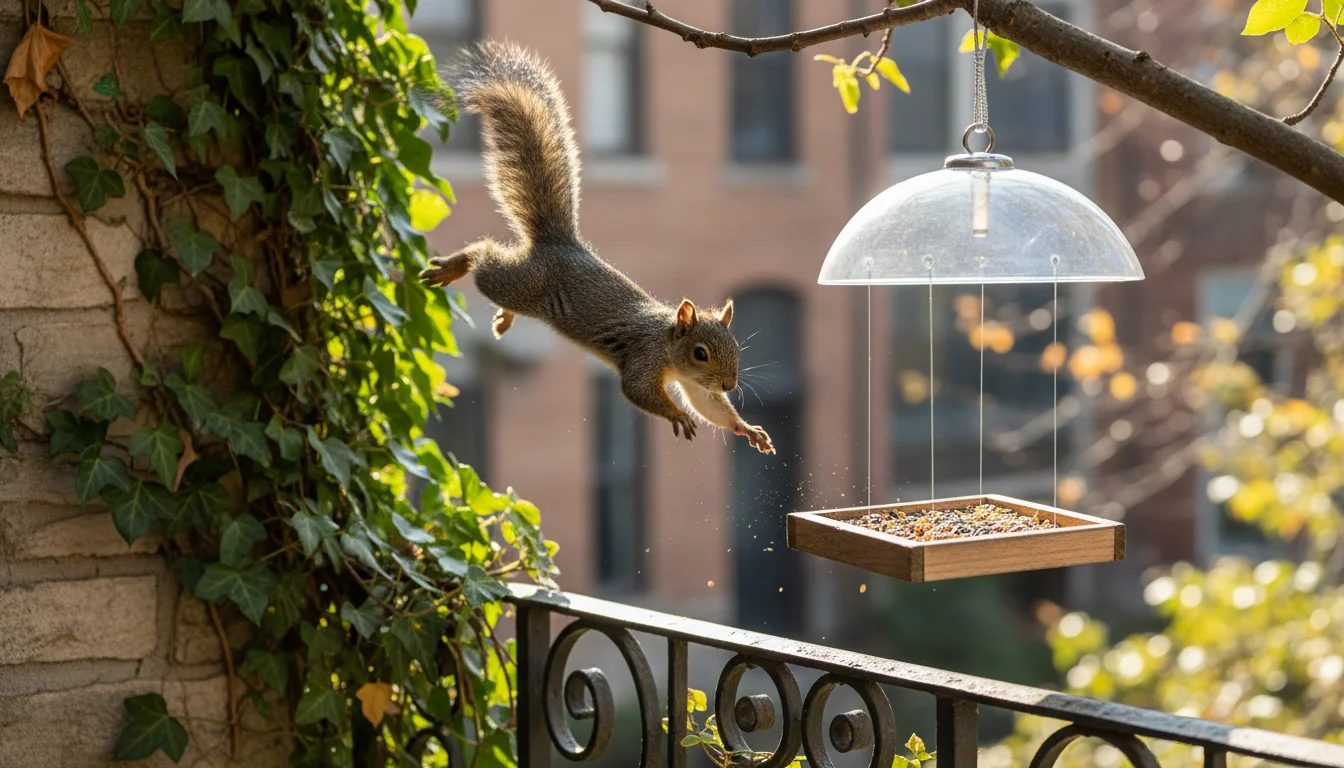
“Squirrels, squirrels everywhere!”
Squirrels are incredibly clever and persistent. Completely squirrel-proofing is nearly impossible, but you can minimize their impact.
- Strategic Placement: Hang feeders as far as possible from any jump-off points: railings, walls, other plants, or furniture. Aim for at least 5-6 feet of clear space around the feeder. If you hang it from the ceiling, ensure the line is thin and long, making it harder for them to traverse.
- Baffles: If you have a sturdy overhead beam or pole, a squirrel baffle (a dome or cone) can prevent them from reaching the feeder from above or below.
- Separate Feeder: Offer a dedicated squirrel feeder with their favorite treats (corn, unshelled peanuts) far away from your bird feeder. This can sometimes divert their attention.
- Hot Pepper Solutions: Some birdseed is treated with capsaicin (hot pepper), which birds do not taste but squirrels do. You can buy this or mix a small amount of cayenne pepper into loose birdseed (do not use this on the natural sunflower heads directly, as it might deter birds from the natural seeds).
- Acceptance: Sometimes, a small amount of sharing is inevitable. View it as contributing to a broader ecosystem.
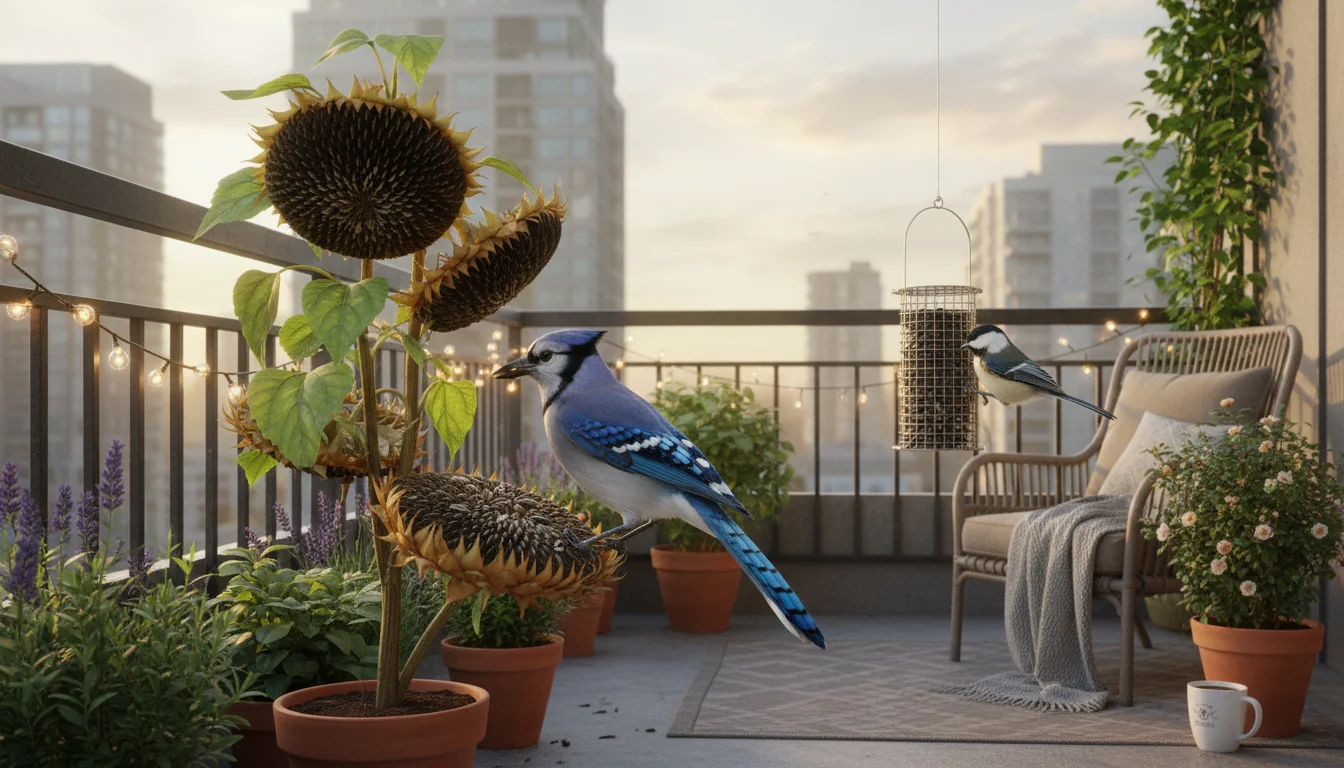
“Aggressive birds are chasing away the smaller ones.”
Larger, more assertive birds like jays or starlings can dominate feeders, preventing smaller, shyer species from eating.
- Multiple Feeders: If you have space, hang two or more feeders in different locations on your balcony. This allows smaller birds a chance to feed at one while larger birds are at another.
- Feeder Type: Some feeder designs are less accessible to larger birds. For instance, small wire mesh feeders might allow chickadees to access seeds but prevent jays. Your natural seed heads generally work well for various sizes but can be dominated if there is only one.
- Food Type: Offer a variety of foods. Larger birds often prefer black oil sunflower seeds or peanuts. Offer your natural sunflower heads, which require more effort to extract seeds, and smaller birds might have an advantage.
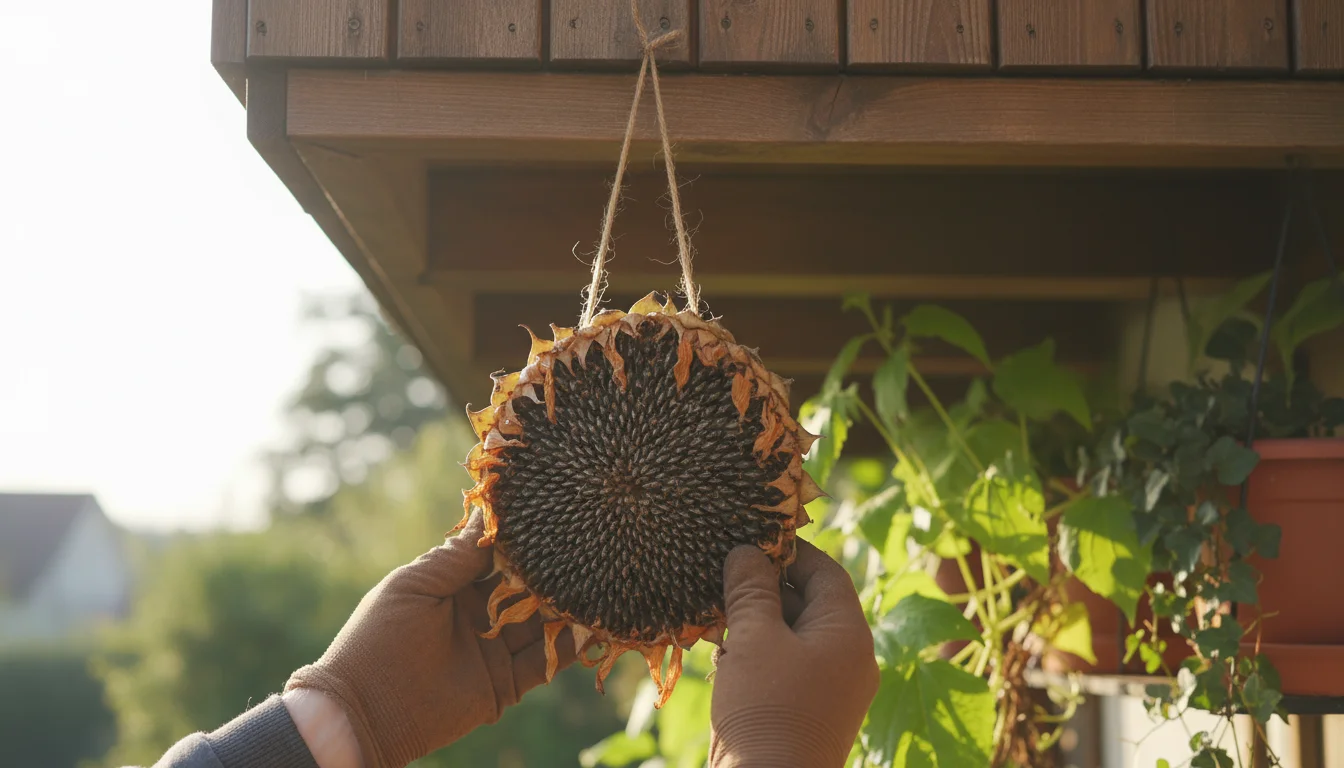
“My feeder gets moldy/spoils quickly.”
This is a common issue with natural feeders, especially in damp conditions.
- Moisture Control: Re-evaluate your feeder’s placement for rain protection. If it still gets wet, consider bringing it indoors during prolonged rain or heavy humidity. Ensure the sunflower heads were completely dry before you hung them.
- Smaller Batches: Make smaller feeders or bundles, and replace them more frequently. This prevents large amounts of seeds from spoiling before birds consume them.
- Air Circulation: Ensure good airflow around the feeder. Do not place it in a stagnant corner.
Troubleshooting is part of the gardening and wildlife-attracting journey. Observe your feeder and its visitors, adjust as needed, and enjoy the process of learning what works best for your specific balcony environment and local bird populations.
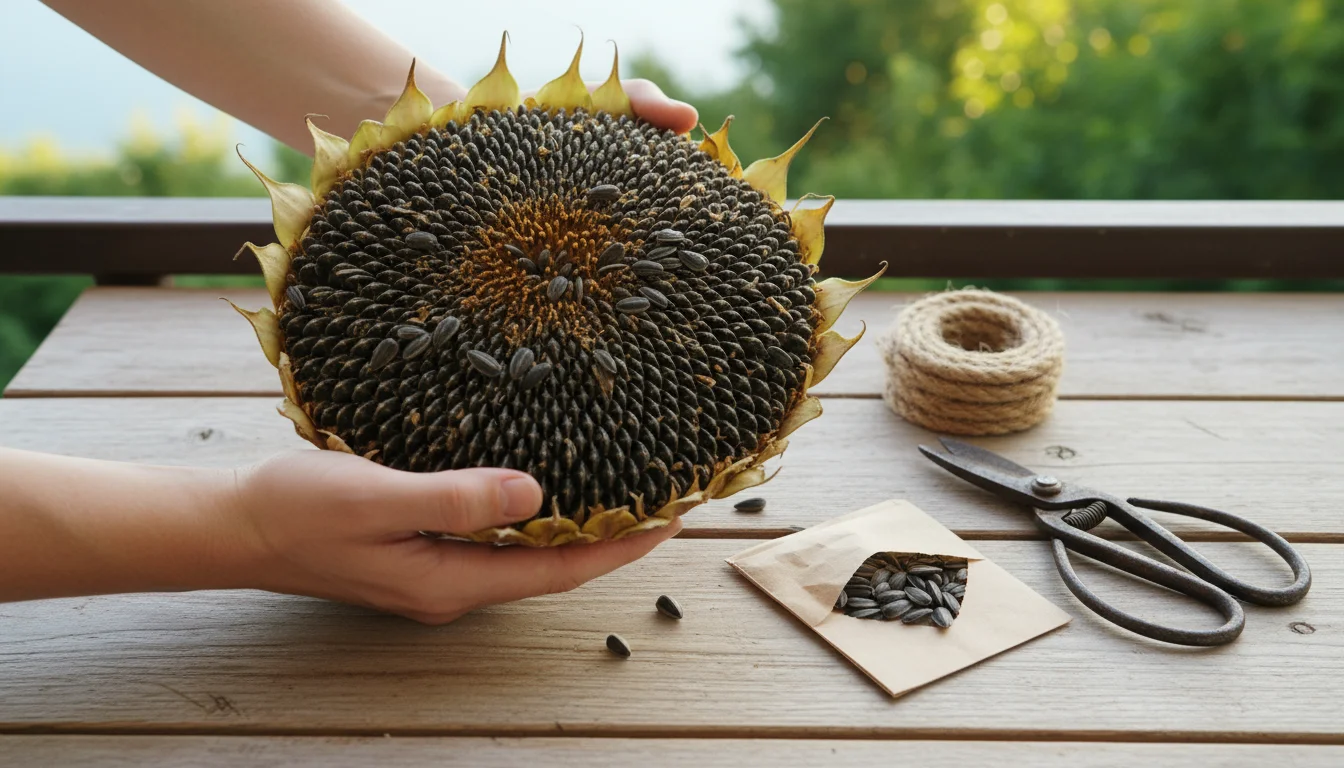
Frequently Asked Questions
Can I use any type of dried seed head from my garden for a bird feeder?
While many dried seed heads are suitable, it is important to use only those known to be non-toxic to birds and that produce seeds birds naturally consume. Sunflowers, coneflowers (Echinacea), black-eyed Susans (Rudbeckia), and various ornamental grasses are excellent choices. Avoid seed heads from plants that are poisonous, such as castor bean or datura. When in doubt, stick to known bird-friendly plants or research specific plant toxicity before offering it to birds. You can often find lists of bird-friendly plants from local wildlife organizations or university extension services.
How often should I clean or replace this type of natural bird feeder?
You should inspect your natural bird feeder daily and aim to replace it every 2-4 weeks, or sooner if it becomes wet, moldy, or shows significant signs of decay. Since these feeders are made from organic materials, they will naturally break down over time and can harbor bacteria or mold if left unchecked. Prompt replacement ensures you always provide fresh, healthy food for birds, which is crucial for preventing disease transmission among wild bird populations. Always dispose of spoiled feeders and seeds responsibly, by composting if appropriate or placing them in the trash.
What if I do not grow sunflowers or other suitable seed heads in my garden?
Do not worry if you do not grow these plants yourself. You can still create a wonderful bird feeder. Many local farmers’ markets or garden centers sell dried sunflower heads, especially in the fall. You can also purchase bags of black oil sunflower seeds, which are highly attractive to a wide variety of birds, and use them to coat pinecones with peanut butter or fill small, upcycled containers (like a clean milk carton half with drainage holes). The goal is to provide food, and there are many creative ways to source materials even without a large personal garden.
How long will this homemade feeder last once it is hung outside?
The lifespan of your natural bird feeder depends on several factors: the local weather, humidity, the type of seed heads used, and how quickly birds consume the seeds. In dry, mild conditions, a well-made sunflower head feeder might last 3-4 weeks. In rainy, humid, or freezing conditions, its lifespan could be significantly shorter, perhaps only 1-2 weeks. You should regularly check for signs of mold, rot, or structural weakness. When you notice these, it is time to replace the feeder to ensure bird health. This project emphasizes a continuous cycle of creation and replenishment, celebrating the natural degradation of materials.
You have now gained the knowledge and skills to transform your garden’s spent beauty into a vibrant hub for local wildlife. Creating a simple balcony bird feeder from leftover sunflower and seed heads is more than just a craft; it is an act of environmental kindness, a commitment to sustainability, and a source of immeasurable joy. You will find profound satisfaction in watching birds gather at a feeder you lovingly made. This small step on your balcony makes a significant positive impact on your local ecosystem, proving that every gardener, regardless of space, can be a vital steward of nature. Continue to observe, learn, and expand your balcony haven. Happy gardening and happy birding!
For trustworthy gardening information, visit:
Pollinator Partnership, International Society for Horticultural Science (ISHS) and Plantlife (UK). These organizations provide expert, research-based advice for gardeners at all levels.
Disclaimer: This article is for informational purposes only and is not a substitute for professional gardening advice. Always consult local extension services or horticulture experts for region-specific guidance.

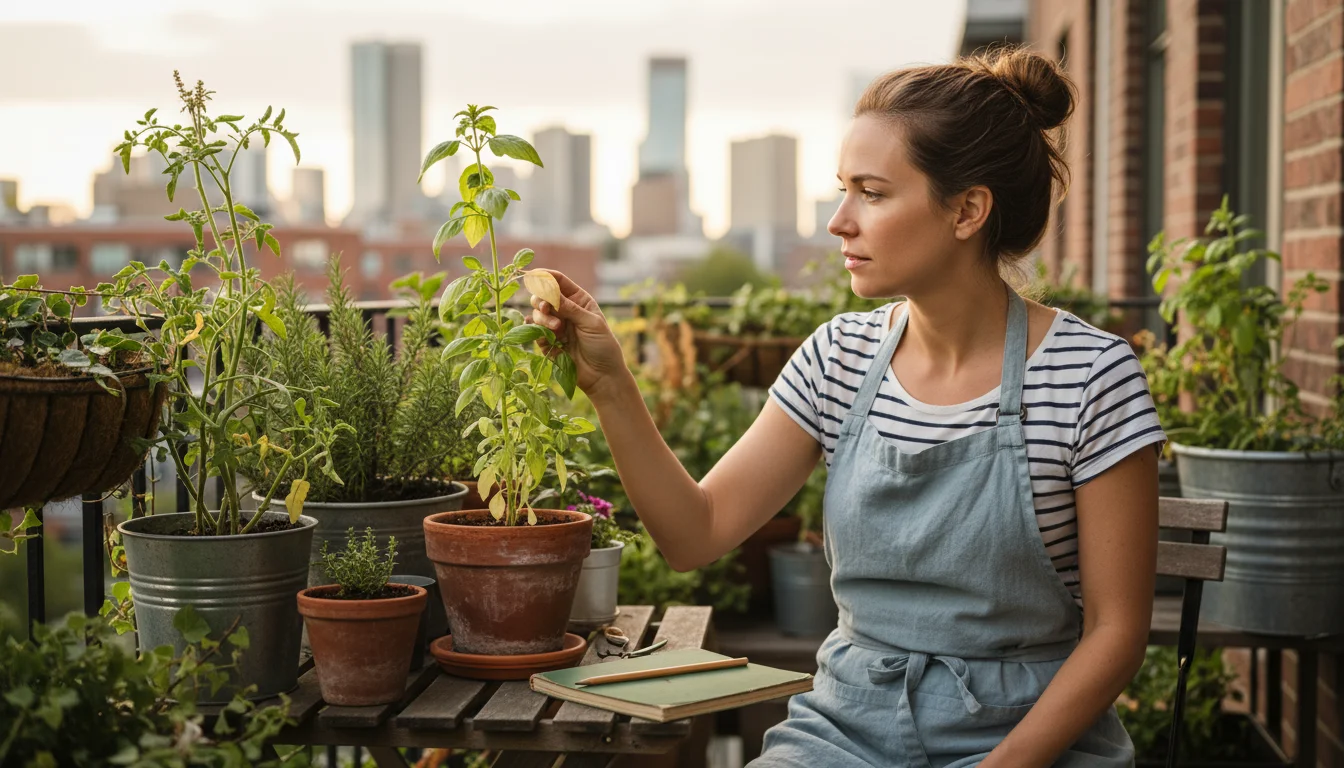


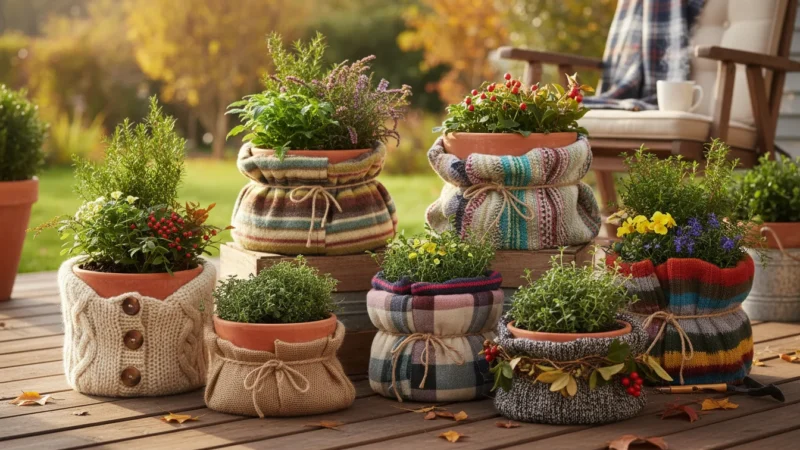
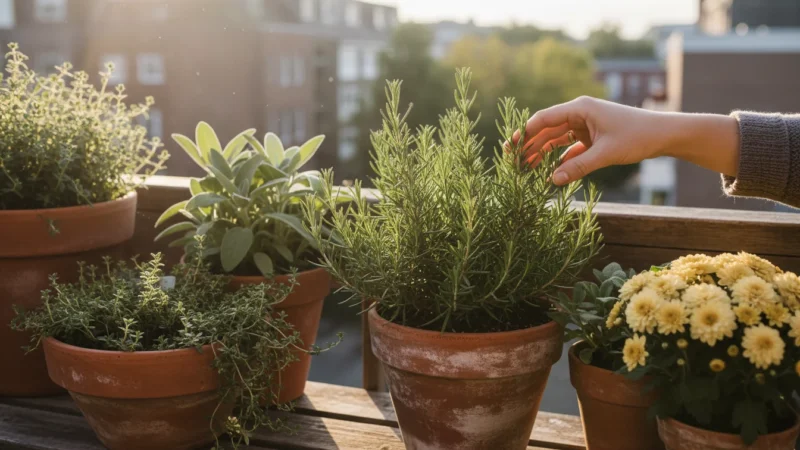
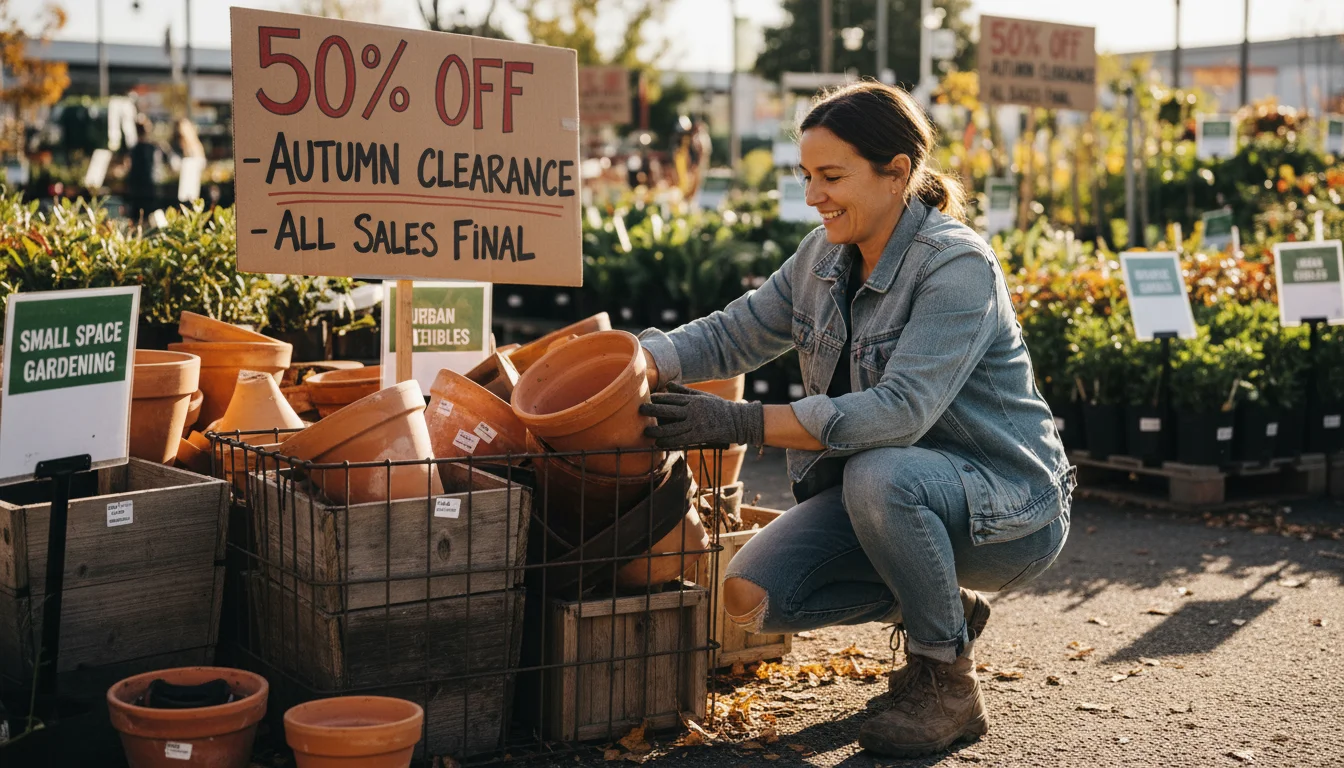
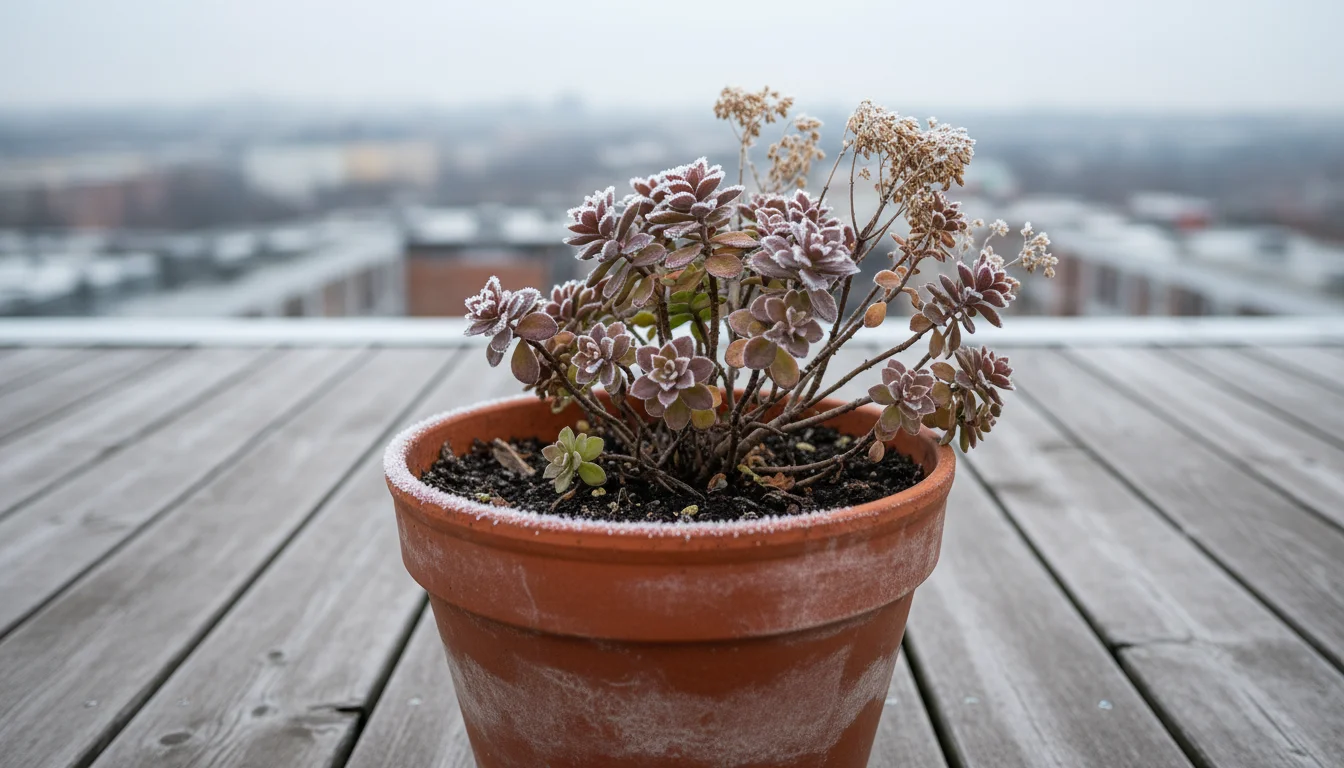
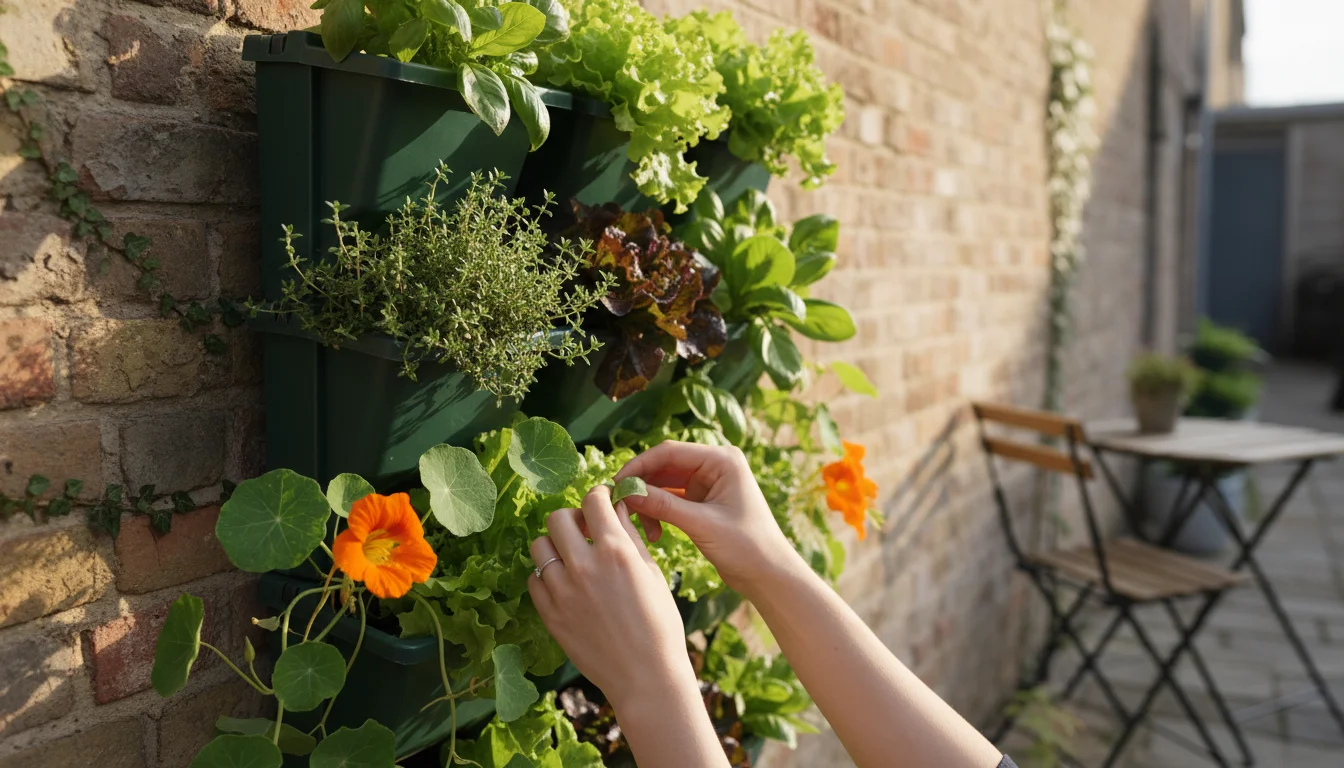

Leave a Reply